Where to have brunch on Jonathan Gold’s 101 Best Restaurants list
- Share via
If you’re a fan of weekend brunch, here are 54 restaurants on Jonathan Gold’s new 101 Best Restaurants list that will serve you a weekend menu of avocado toast (of course), or galbi jjim (Korean short-rib stew), tacos or excellent pastries and pancakes, or dim sum.
Taco Maria
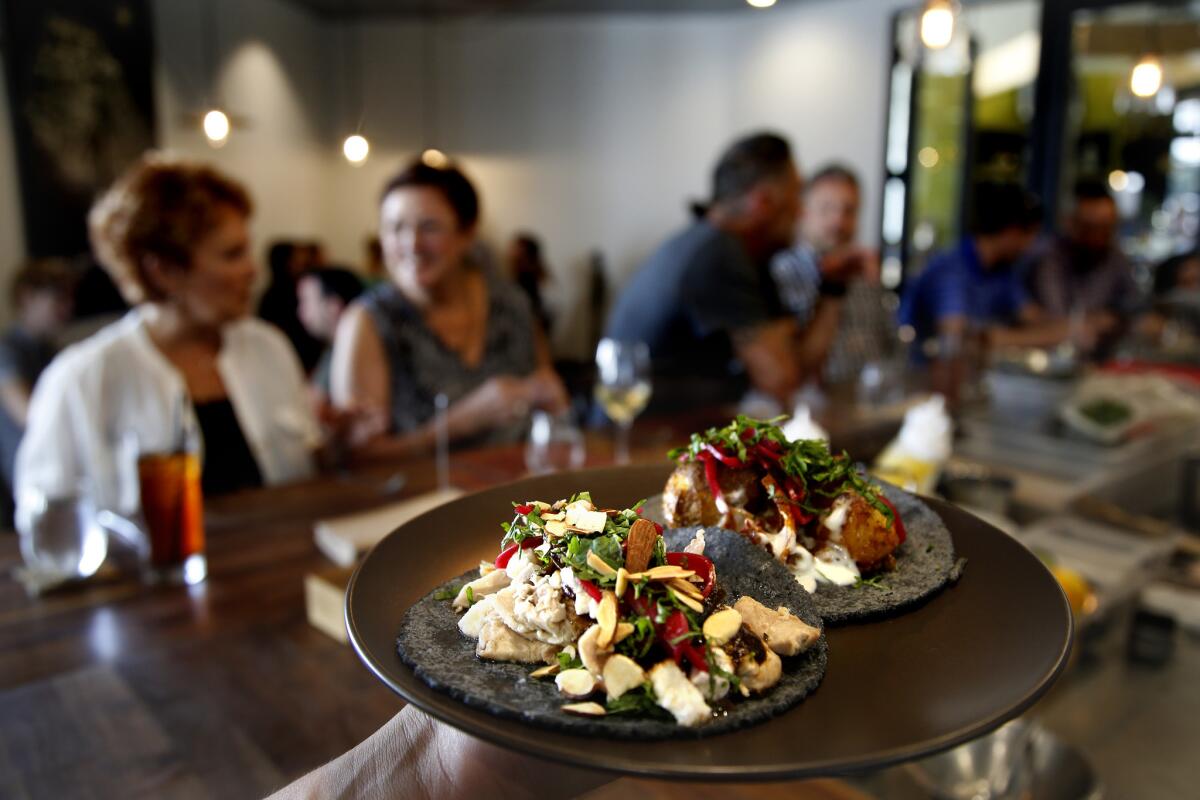
The pork terrine with purslane, the gorditas with caviar and herbs, and the complexly spiced ceviche really could slide onto the menu of a place like Providence or Coi, without losing the essence of their Mexican soul. A scallop in its shell, briefly broiled under a pinch of cheese and squid ink-saturated bread crumbs, could be a new classic. You can get tacos at lunch. Chef Carlos Salgado works harder to source the Atlacomulco corn he nixtamalizes for his tortillas and tamales than most chefs do their fish.
Spring
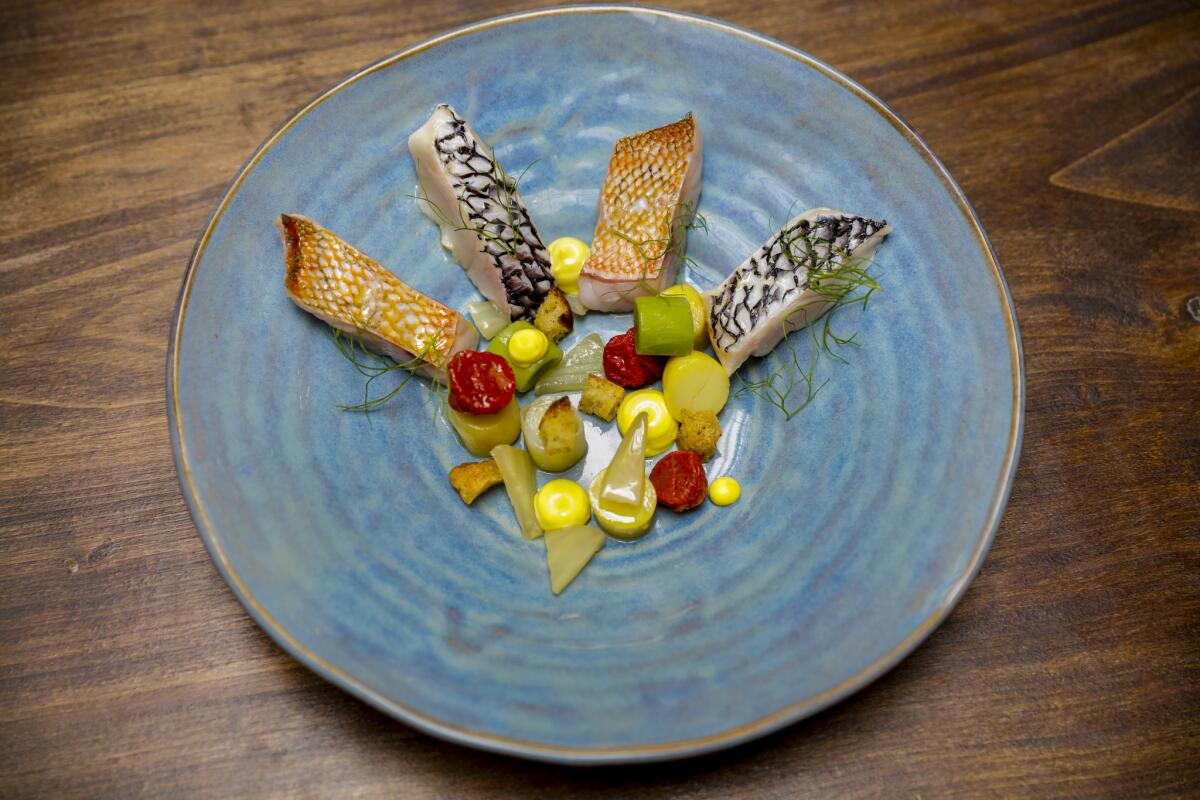
Spring is the loveliest French restaurant to open in Los Angeles in years, an actual glassed-in 19th century courtyard graced with chef Tony Esnault’s sunny Provencal cooking. There is nothing in L.A. remotely like his salad of wild-caught Burgundy snails, his duck breast with salsify, or his spectacular, saffron-intensive take on the Provençal fish stew bourride. And somehow, dinner here seems to cost about what it does at Esnault’s unpretentious bistro — even less when you visit the sun-splashed courtyard for a delicious $26 set-course lunch, flat-out the best dining bargain in town.
Pizzeria Mozza (part of the Mozzaplex)
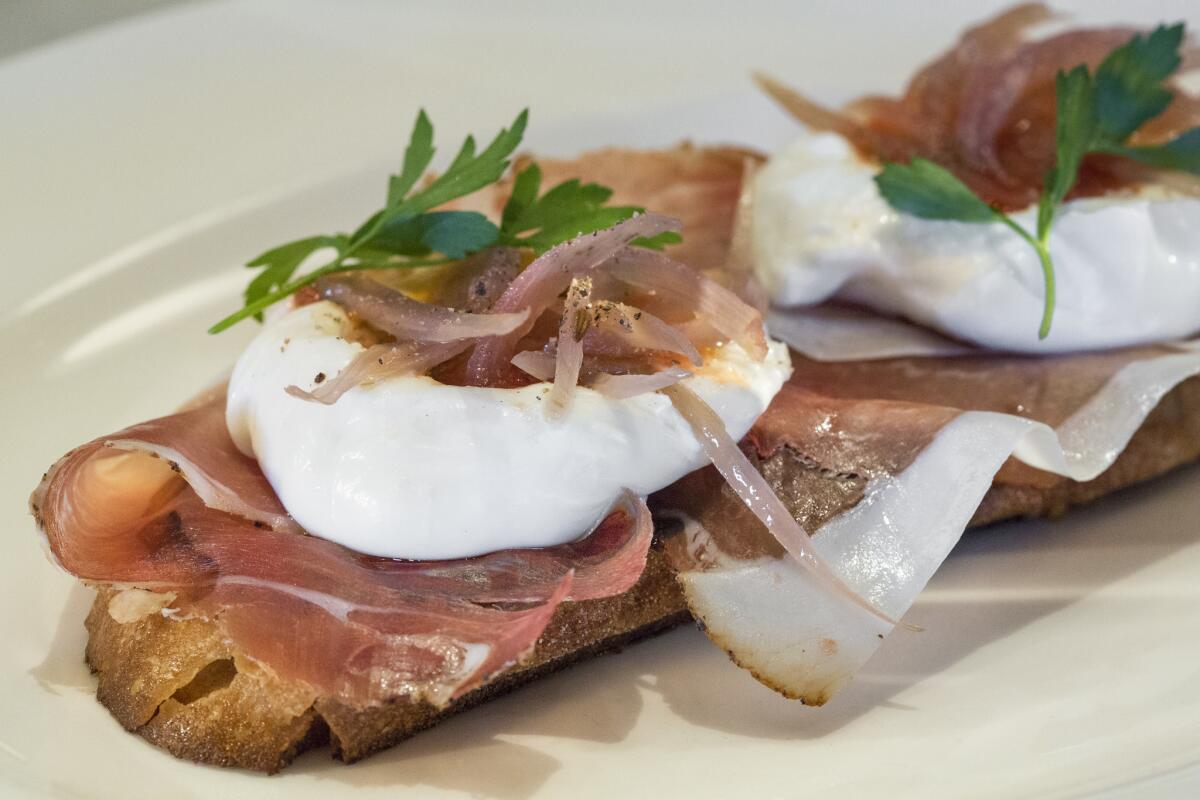
Pizzeria Mozza ranks among the best pizzerias in the United States — its crisp, risen, wood-fired pizzas are unlike any particular Italian style, but the crust is good enough to eat even without squash blossoms and burrata. Any of the four restaurants in the Mozzaplex (Pizzeria Mozza, Osteria Mozza, Mozza2Go and Chi Spacca) could well make this list on its own; together they form an unassailable rampart of urban rustic cuisine.
LASA
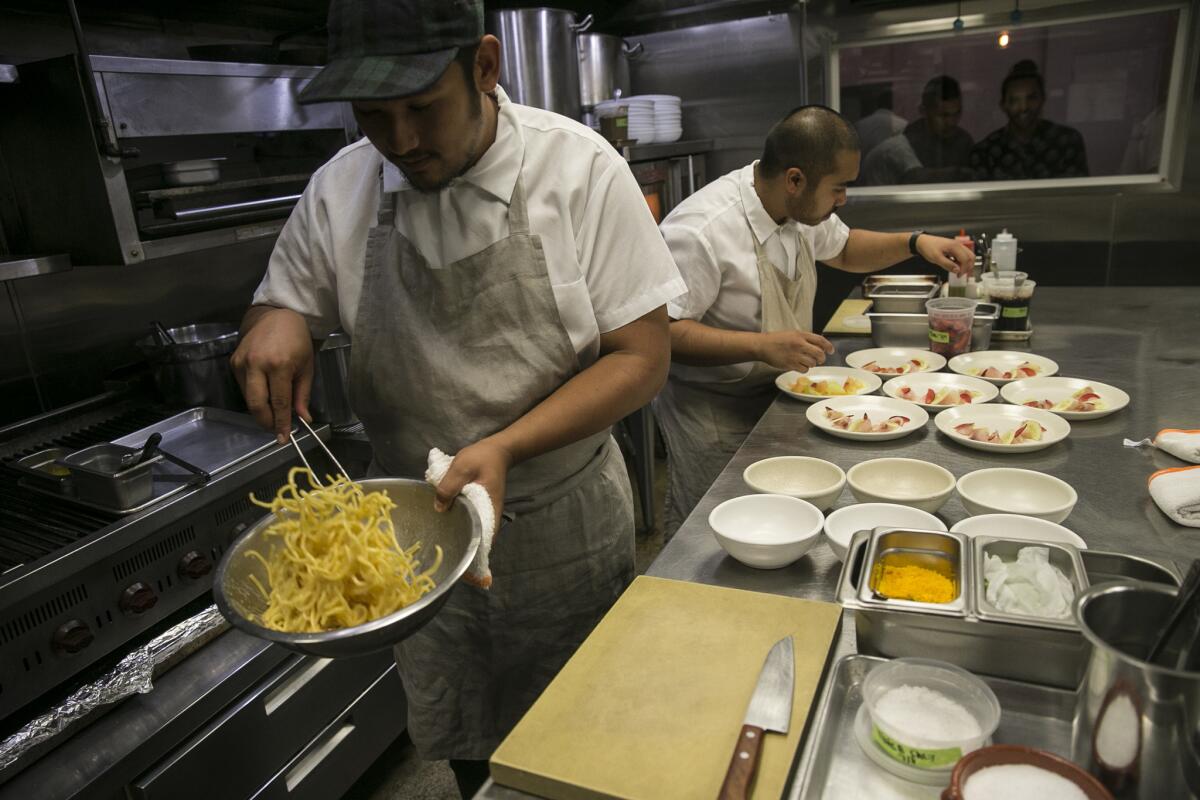
Nobody has quite caught the spirit of modern Filipino cooking like Lasa, who moved permanently into the small, chic ex-pho shop in which they had been running a pop-up for months. Chad Valencia’s cooking captures the extreme regionality of the dishes in the Philippines’ zillion islands. He slashes refreshing vinegar and citrus notes with the funk of fish sauce, in the ceviche kinilaw, for example, or in Filipino beef tartare. He takes advantage of the cuisine’s tendency to accommodate both vegetable-forward and nose-to-tail sensibilities, sometimes in the same dish: crisp pigtails with thinly sliced turnips or chunks of braised, crisped pork belly with squash, served over a silken, smoky purée of roasted eggplant.
Republique
Does République make you want to be a better person? République does not. Because while it is a very nice place, with a good French-dominated wine list, Walter Manzke’s turbocharged bistro cooking could turn just about anyone into a gibbering, gluttonous fool. The baguettes come with a choice of Normandy butter or a small pot of pan drippings — pan drippings! If you are looking for the best French fries in Los Angeles, the ones here are pretty close, cooked in a complex multi-step process that makes them all the crunchiest ones on the plate. You obviously can’t eat all of the things, but you want to eat all of the things — and even if you virtuously limit yourself to a plate of crudo and a tomato salad, you will have lusted in your heart. This isn’t to say you should skip dessert, by the way. Margarita Manzke’s version of halo-halo is crazy good.
Animal
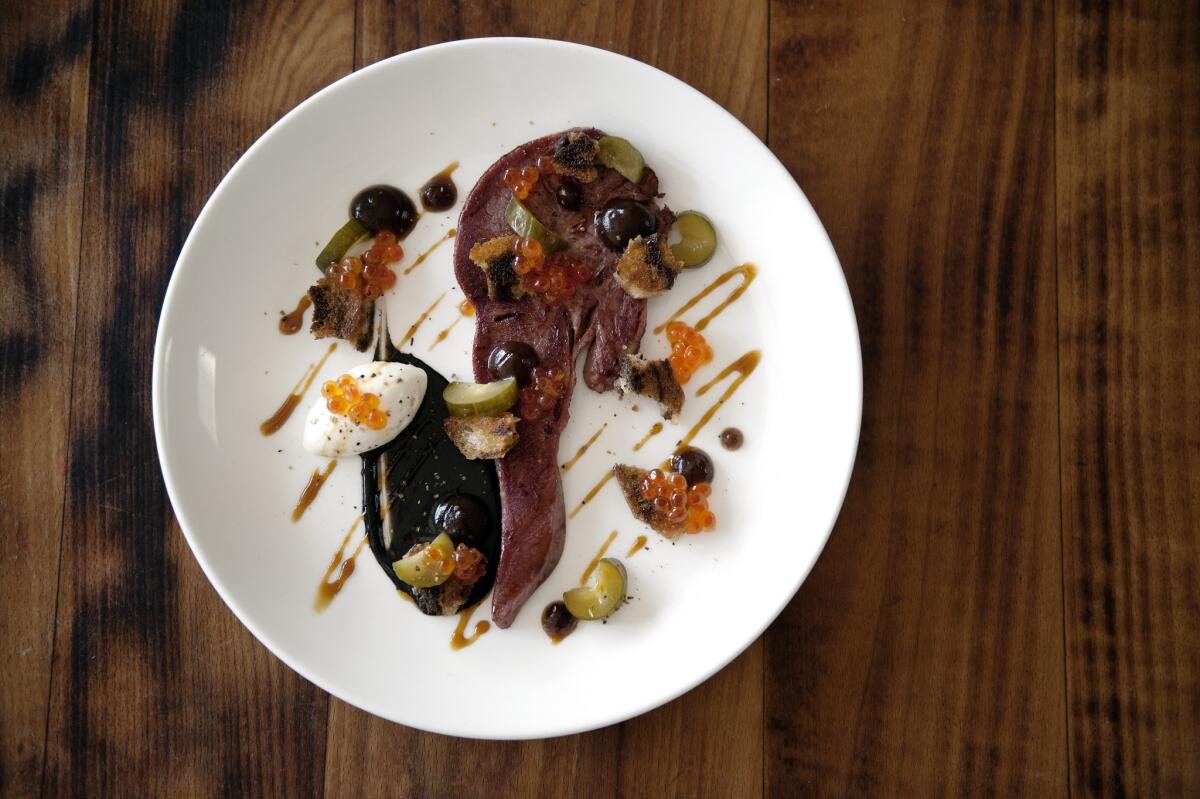
Los Angeles, outsiders say, is a city of virtue signaling, a place where yoga-toned citizens spend most of their time test-driving Teslas, walking rescue labradoodles up Runyon Canyon, and nibbling on maca and activated cashews. This, of course, must be between meals at the cheerfully horrifying Animal, where Jon Shook and Vinny Dotolo sling quivering veal brains with vadouvan, lakes of cheese melted with chorizo, fried rabbit legs with cream gravy, and pig’s ear terrines, as if their only stated goal in life is to make Gwyneth Paltrow regret every one of her life’s choices. Animal is often the first place visiting chefs stop when they come through town because nobody understands the slightly gross chef’s appetite like Shook and Dotolo, for whom the foie gras loco moco and the bacon-chocolate crunch bar are alpha and omega. The wine list, put together by Helen Johannesen, is unexpectedly baller.
Kismet
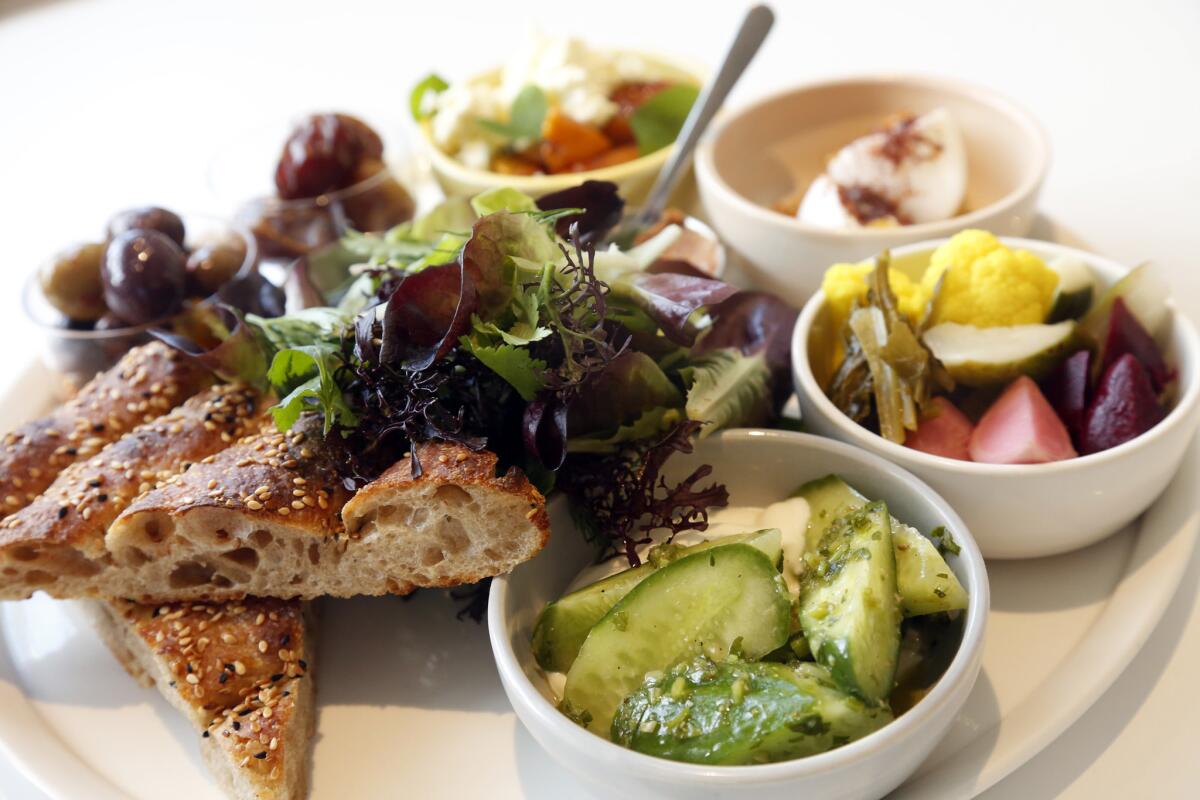
The aesthetic of co-chefs Sara Kramer and Sarah Hymanson, whom you may know from Madcapra in Grand Central Market, expresses both the landscape of California and the lingering flavors of the Levant, directed by the snap of local vegetables and the ancient tang of ferment, with bits of animal coming in at the edges if at all — the best dish in the place may be the lunchtime procession of vegetables, cheese and flatbread called accurately “all the things.” Still, if you have a little money in your pockets, you might try the huge rabbit platter, which includes stew, roasted legs and a kebab with caramelized squash. It feeds two — maybe as many as four, if you all happen to be wearing skinny jeans.
Manuela
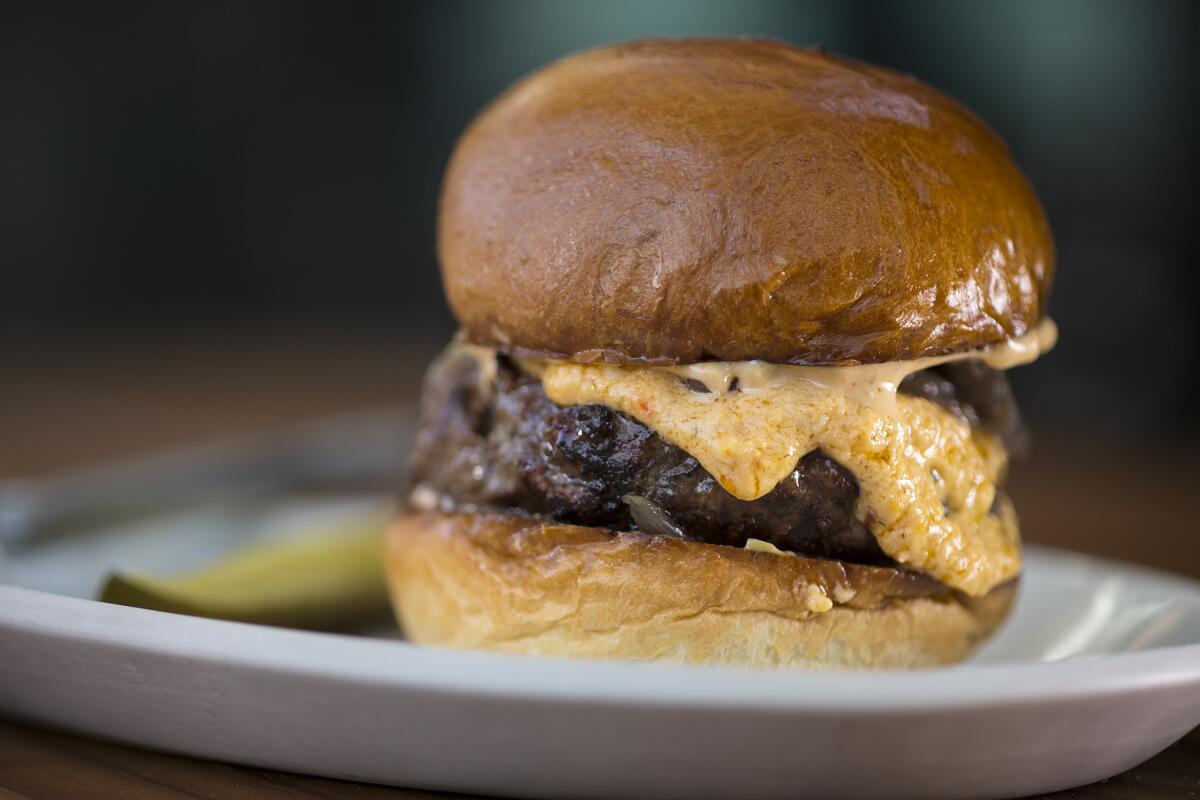
If you should find yourself at Manuela, the restaurant at the heart of the Hauser & Wirth art complex, you should probably order a “Redneck” platter the minute you sit down. There is shaved country ham and a mound of soft pimento cheese, pickled vegetables and hot biscuits, and deviled eggs that would not be out of place at a proper Georgia funeral. You may be sitting under a Mark Bradford painting of the Hollywood street grid, but as far as Wes Whitsell is concerned you are in the small-town mid-South. If you continue your meal with hush puppies, a venison burger and a plate of barbecued quail, Whitsell, a chef who gathers eggs from the chickens he raises out back, won’t mind a bit. If you are the kind of person who enjoys the pleasures of a buzzy restaurant but yearns wistfully for cornbread and collards, fried chicken and butter-pecan ice cream for dessert, Manuela may be the fine-dining restaurant for you.
P.Y.T.
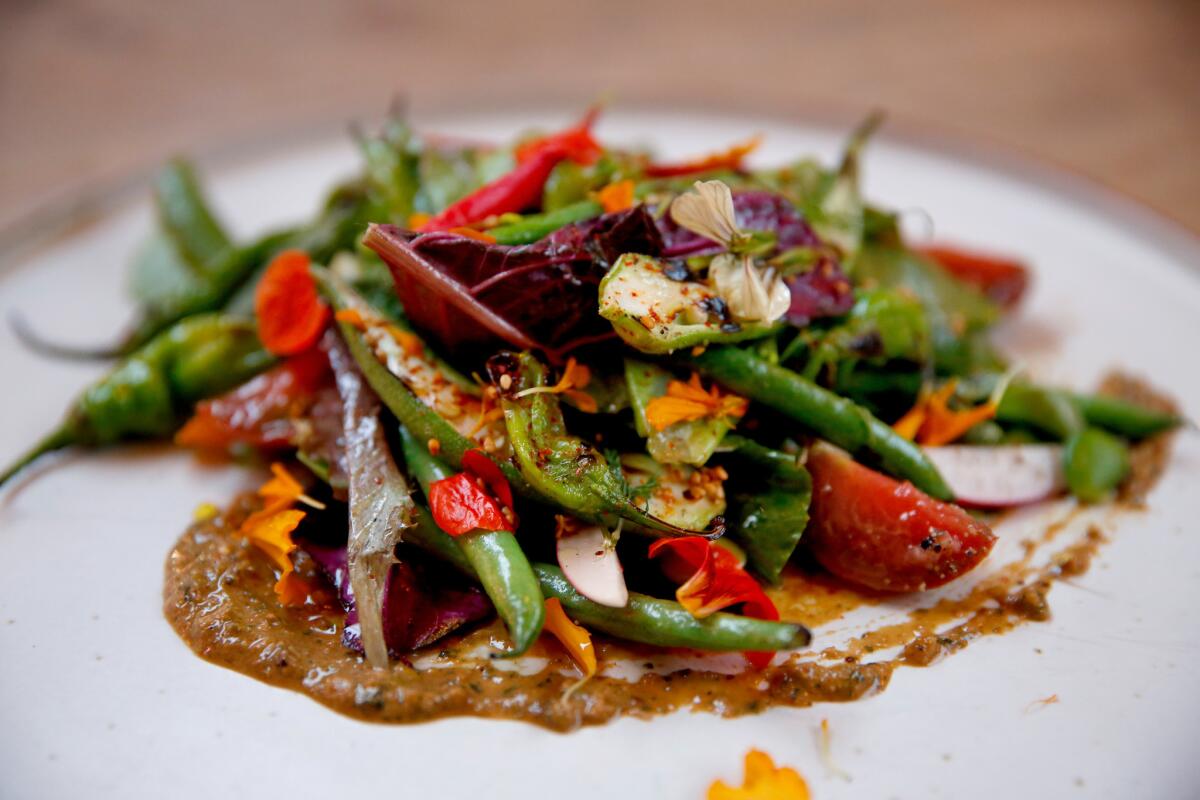
P.Y.T., carved out of the southern end of Ledlow, is Josef Centeno’s first vegetable-centered restaurant. It is a place of feathery herbs, local grains, unlikely pestos and smears of strong cheese; a place where the herbed piri-piri rice, fried squash blossoms and grilled baby corn are the stars and the single pork dish is cordoned off at the bottom of the menu like the token steamed-vegetable plate at most mainstream places. The food isn’t vegan but most of it can be if you ask. You’re not here for authentic versions of things you’ve tasted before; you’re here to taste the produce of the season, much of it obtained through Centeno’s relationship with a nearby high school garden, transformed.
Guerrilla Tacos

If you were trying to choose a kitchen most emblematic of the Los Angeles food scene at the moment, Guerrilla Tacos is a good place to start. Wes Avila trained with Gary Menes, Walter Manzke and Alain Ducasse before he ditched the world of fine dining to start making tacos. He uses the same farmers market produce, high-end seafood and sustainably raised meat as the best chefs in town, including the occasional Perigord truffle. His sauces are exquisite. And if you happen to be by Blacktop or Cognoscenti Coffee when his truck rolls by, you can eat what is in effect a first-rate tasting menu, except that you are sitting on the curb instead of having a white tablecloth spread before you, the dishes come rolled into tortillas instead of on fine china, and you are spending a tiny fraction of the cost.
Chengdu Taste
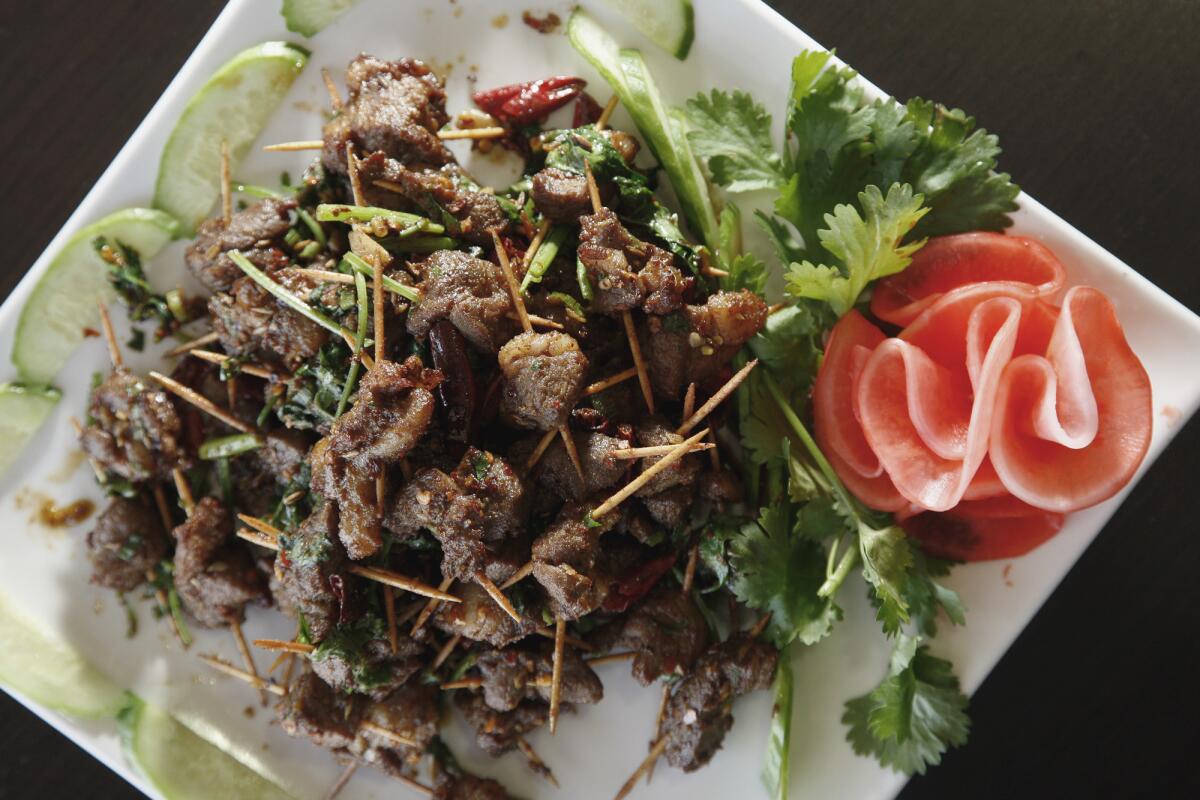
Chengdu Taste is the most influential restaurant in the San Gabriel Valley, the place you take visiting friends when you want to tempt them to move to L.A. Its success has inspired dozens of similar restaurants, some of them direct imports from China. Tony Xu’s cooking is light and clean but spicy as hell, flavored with a shop’s worth of fresh, dried, pickled and ground chiles, but the layers of flavor are clear, and vivid heat.
Otium
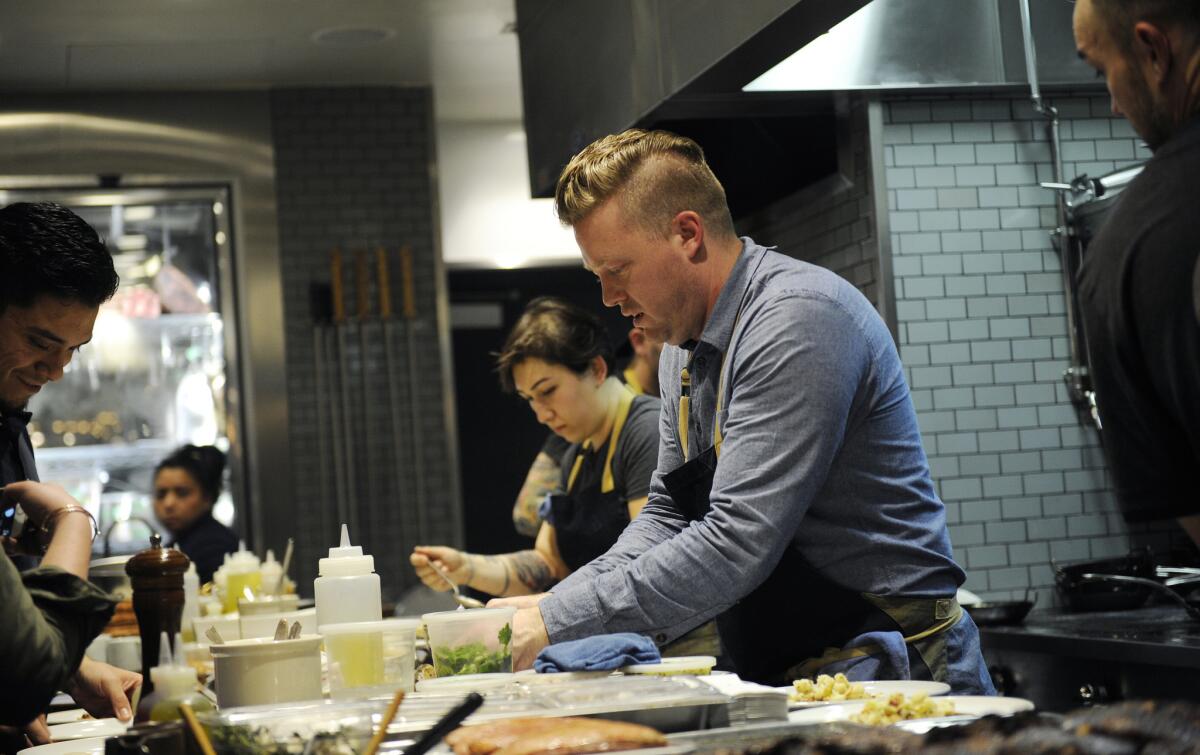
Timothy Hollingsworth’s grand project at Otium is to do no less than redefine what an American restaurant might be, to wrest the conversation away from both European-trained chefs like his mentor Thomas Keller and from heritage cooks like the late James Beard, and focus it toward the glittering mosaic of cookery that California actually experiences today. In practice, this involves blowing through a lot of different cuisines in the course of a small plates meal — raw fish that expresses itself as sashimi; steak tartare that resembles kibbeh nayeh; grilled cheese sandwiches stuffed with truffles and country ham. The cooking in this modernist pavilion is precise and well-reasoned — Hollingsworth is a haute cuisine guy to the tip of his toes.
Soban
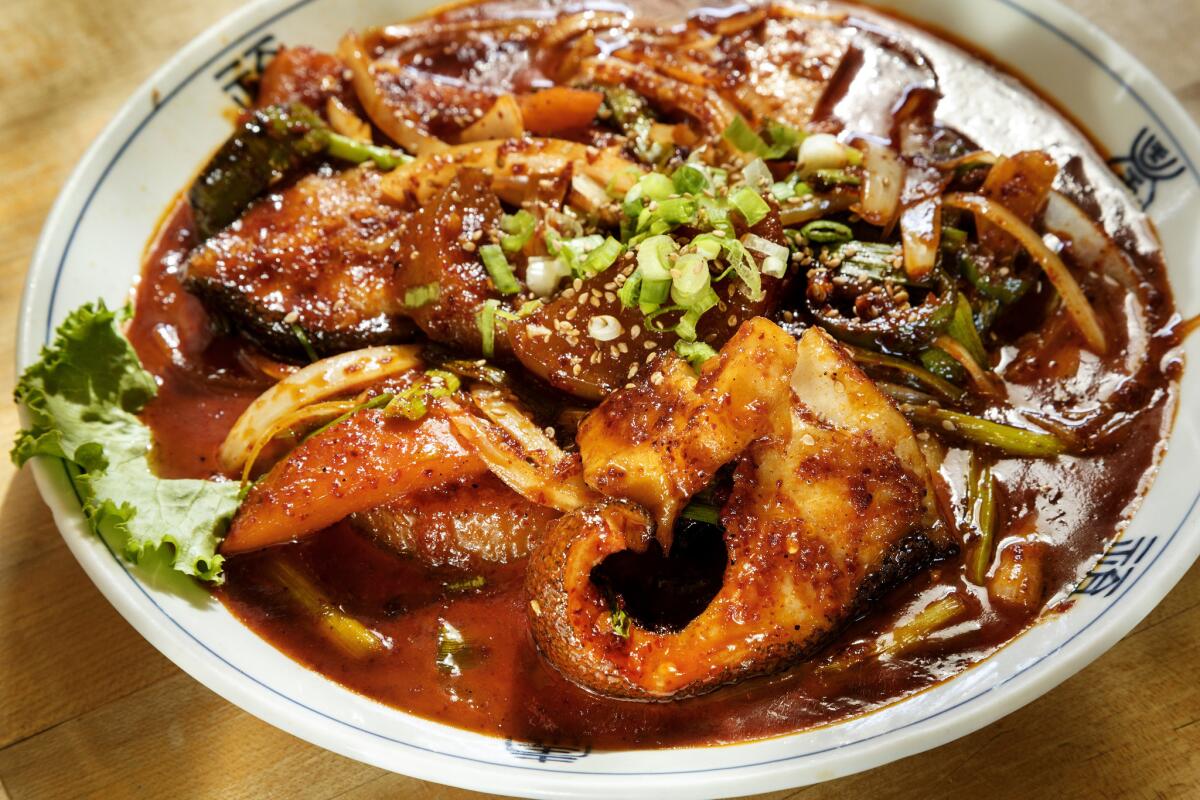
When somebody asks me to name the best dish in Koreatown, I invariably tell them to try Soban’s ganjang gaejang, an ultrafresh raw crab briefly marinated in house-made soy sauce — a glorious, gelatinous, sea-briny mess. If Soban weren’t so genteel, you can almost imagine yourself wrestling for the leg, scooping up rogue lumps of roe, or turning the shell over to scrape out whatever fragments of tomalley might have adhered to the inside. Before the crab, there will have been Soban’s famous presentation of 13 or so banchan, the tiny side dishes that form Act 1 of a Korean meal.
Pizzana
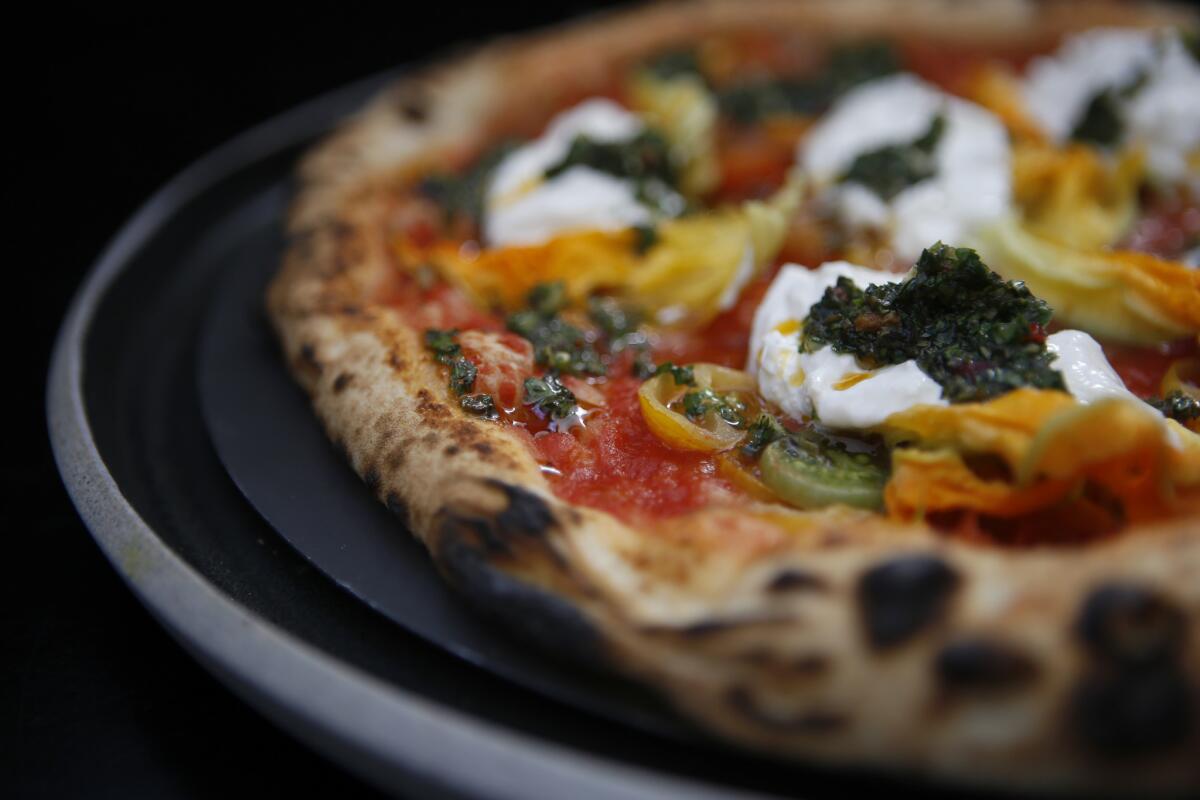
Can a pizza have a pedigree? Daniele Uditi earned his bones at his family’s bakery near Caserta, the buffalo mozzarella capital of Italy, as well as in one of the best pizzerias in Naples. Uditi favors a slow pass through his fiery wood oven and a crust edged with crispness. There are pizzas based on classic pasta preparations, including an awesomely garlicky pizza made to taste like Roman aglio e olio, and a pignatiello pizza topped with a grandmotherly Neapolitan ragù. His dough, made completely by hand in a traditional wooden bin, is allowed to ferment for nearly two entire days. Uditi is the real thing.
Sun Nong Dan
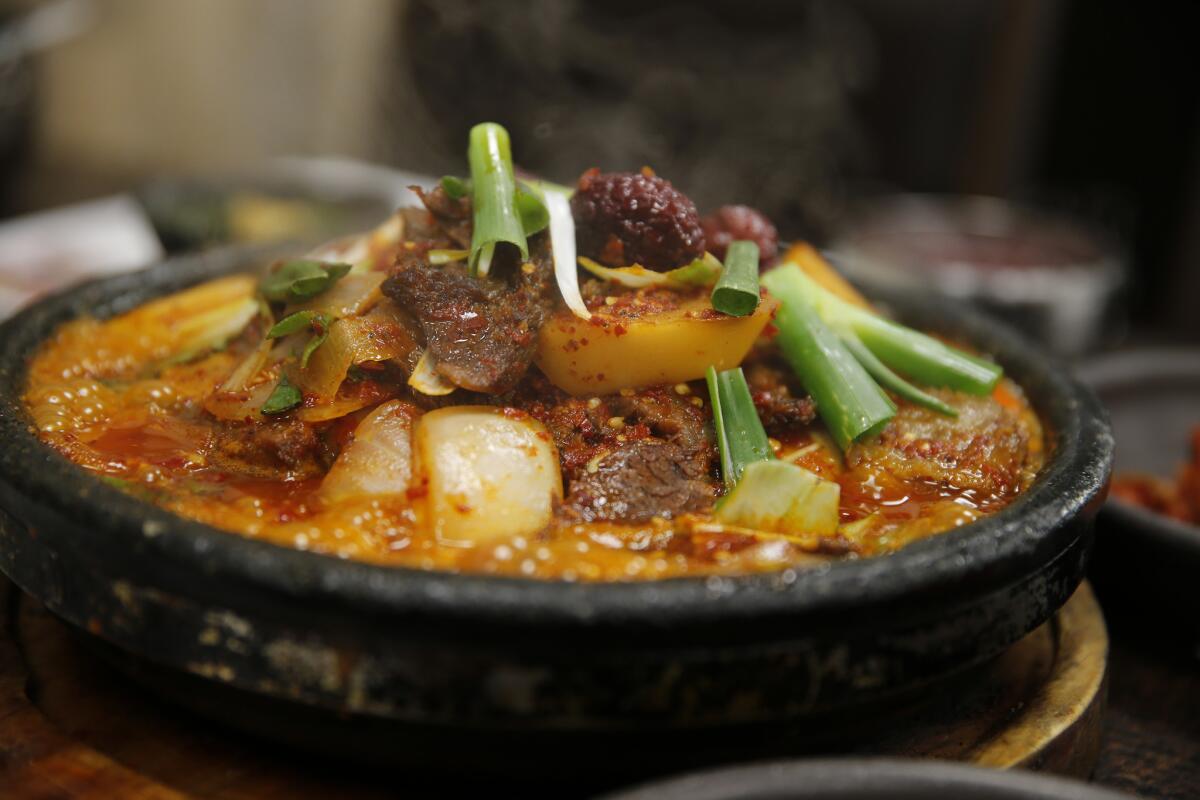
The restaurant is named after an archaic term for sullongtang, a gentle bone broth famous for its effectiveness as a morning-after tonic. But the swelling crowd outside the tiny Koreatown storefront is there for the short-rib stew, galbi jjim, which is pretty much everything about Korean cooking cranked up to 10 — a violent red lagoon of meat and broth, hissing and bubbling, enveloped in a small universe of steam. If you have ordered it with cheese — you have to order it with cheese — a waiter scoops a big handful of white stuff over the top and blasts it with a torch. Galbi jjim is a staple of both royal Korean cuisine and Sundays at Grandma’s house. At Sun Nong Dan, it’s David Choe blasting spray paint onto an alley wall.
Holbox/Chichén Itzá
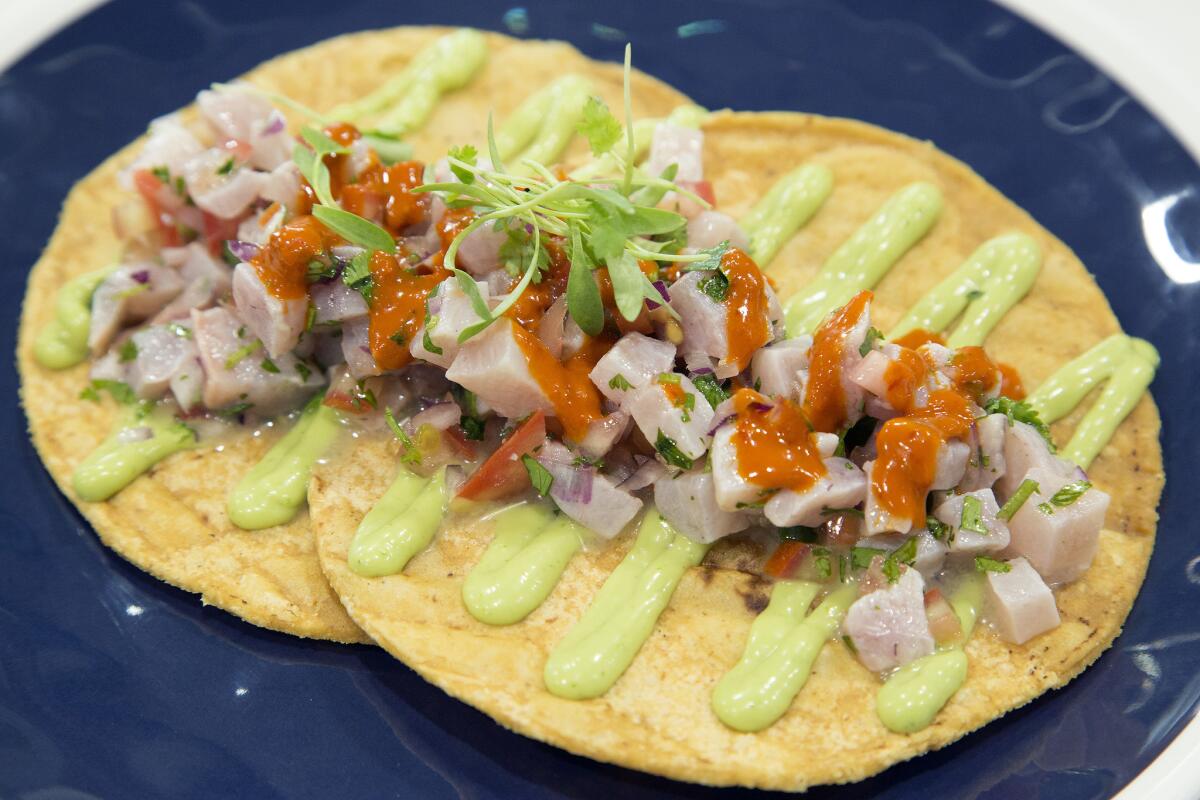
Holbox is the new Yucatán-style seafood restaurant from Gilberto Cetino Jr., whom you may know from Chichén Itzá. Like Chichén Itzá, Holbox occupies a corner of the Mercado La Paloma complex. As at Chichén Itzá, you wait in line to order, and commandeer as many kinds of chile sauce as you are allowed. As at Chichén Itzá, you will wind up with twice as much food as you thought you might be — especially if you also walk over to Chichén Itzá and order a couple of panuchos and a plate of papadzules to go along with your seafood.
There are huge surf clams, marinated in bitter orange juice, spilling in swirls from their shells; huge, fresh oysters from Oregon; and one of the best shrimp cocktails in the city — plump, crisp bits in a purée-filled sundae glass crowned with a single steamed prawn. The blood clams surpass what you’ve had at the famous Baja street stands. The tortas, butter-crisped French rolls stuffed with avocado and breaded shrimp, are predictably spectacular. And the yellowtail-uni ceviche is magnificent, melting into the sharp chile-lime snap of its marinade, with a glorious excess of rich, fresh sea urchin roe.
Gjelina
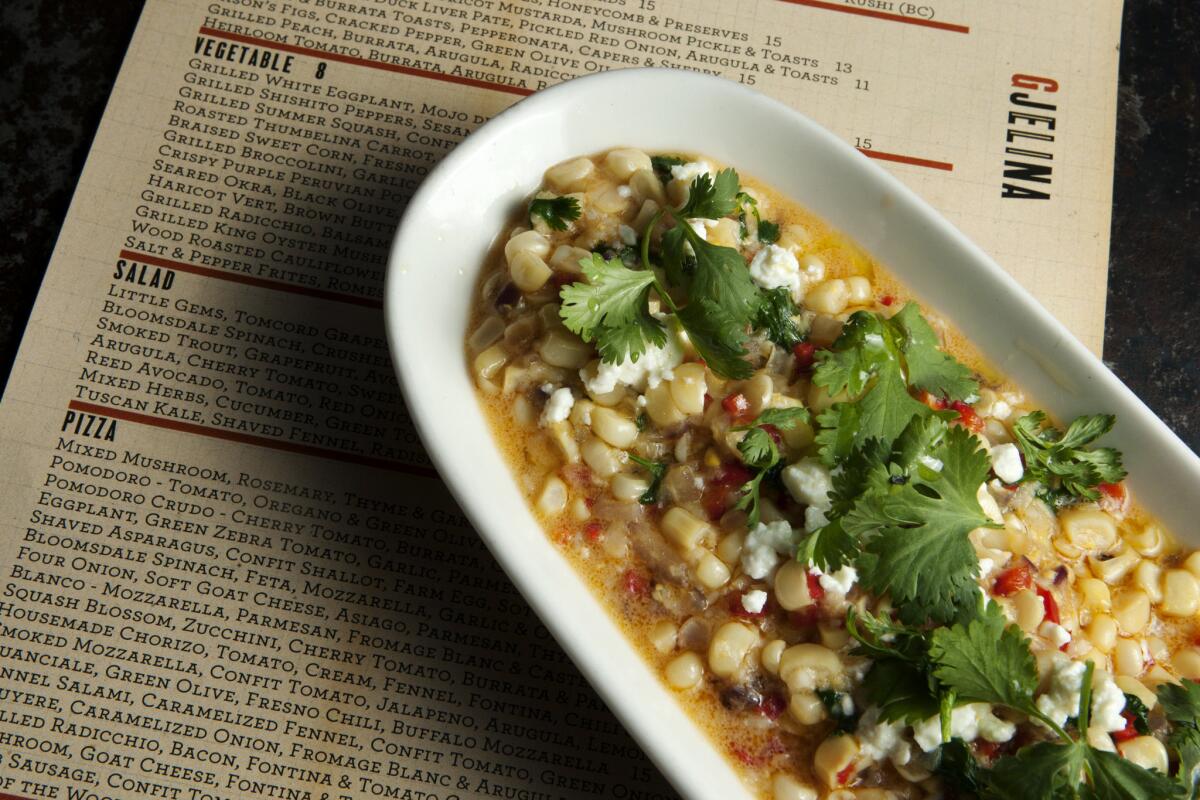
Gjelina has been open for almost a decade now. The turnover on Abbot Kinney has almost been complete. Travis Lett himself seems to be focusing his attention on the new izakaya MTN down the street. And yet Gjelina is still the restaurant everybody wants to go to — for its anchovy burrata toast, for its local squid with black-eyed peas and for its thin-crusted pizzas, but mostly for its vast selection of vegetable dishes, which channel the hyperseasonal shell beans and squashes and greens from the farmers market into vaguely Mediterranean compositions just big enough to be shared. It’s almost as if Lett understands us. If you want to hear what your friends are saying, try to get one of the tables in the patio.
Salt’s Cure
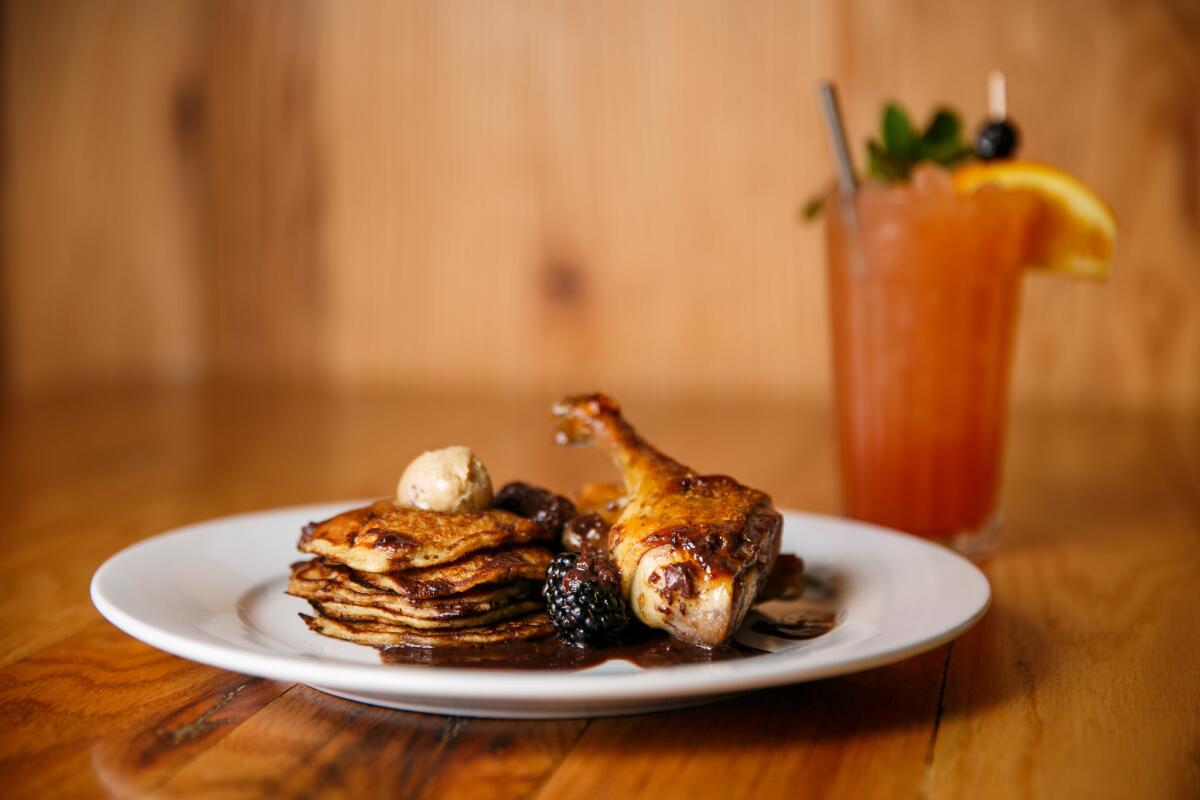
Could the best pork chop in town be the one Chris Phelps serves at the relocated Salt’s Cure, his plain, meat-oriented restaurant up on Highland? It just might be — a full pound of sustainably raised Marin Sun Farms pork from Northern California, lightly marinated and cooked slowly, so that the thin rim of fat crisps while the juices concentrate in the meat, and the pork tastes intensely, gloriously of itself. “I’d been at my last restaurant for almost eight years,” a server confessed. “But I wanted to work with people who could cook a pork chop like that.” See if you can score a short stack of the buttery, crisp-edged oatmeal griddle cakes to go along with the chop. (The pancakes are also a highlight of Salt’s Cure’s wonderful brunch.)
Salazar
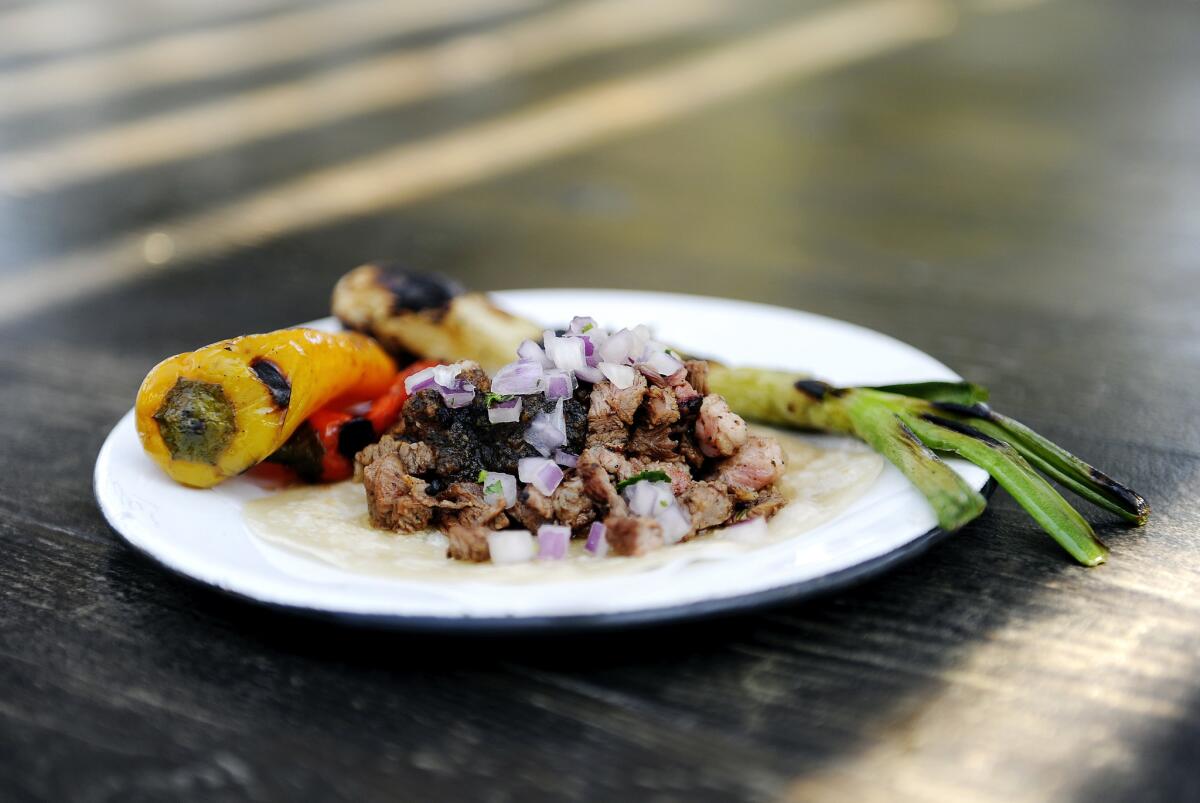
Salazar is the kind of restaurant you’d think there’d be millions of in Los Angeles, a laissez-faire outdoor dining room more Austin, Texas, than California, with a smoggy view out over the river, margaritas for days and a menu centered on grilled meats and beer. Sometimes people bring their dogs. Everybody sooner or later gets around to inhaling a taco or two. Esdras Ochoa’s carne asada is simple but perfect, grilled over blazing hot mesquite, chopped and stuffed into a flour tortilla. His marinated pork al pastor is sweet, slightly charred, with a bit of burnt pineapple. You can supplement the tacos with a cocktail of cold, wild-caught shrimp from the Gulf of Mexico, an anchovy-forward Caesar salad or a gooey potato purée.
Sqirl
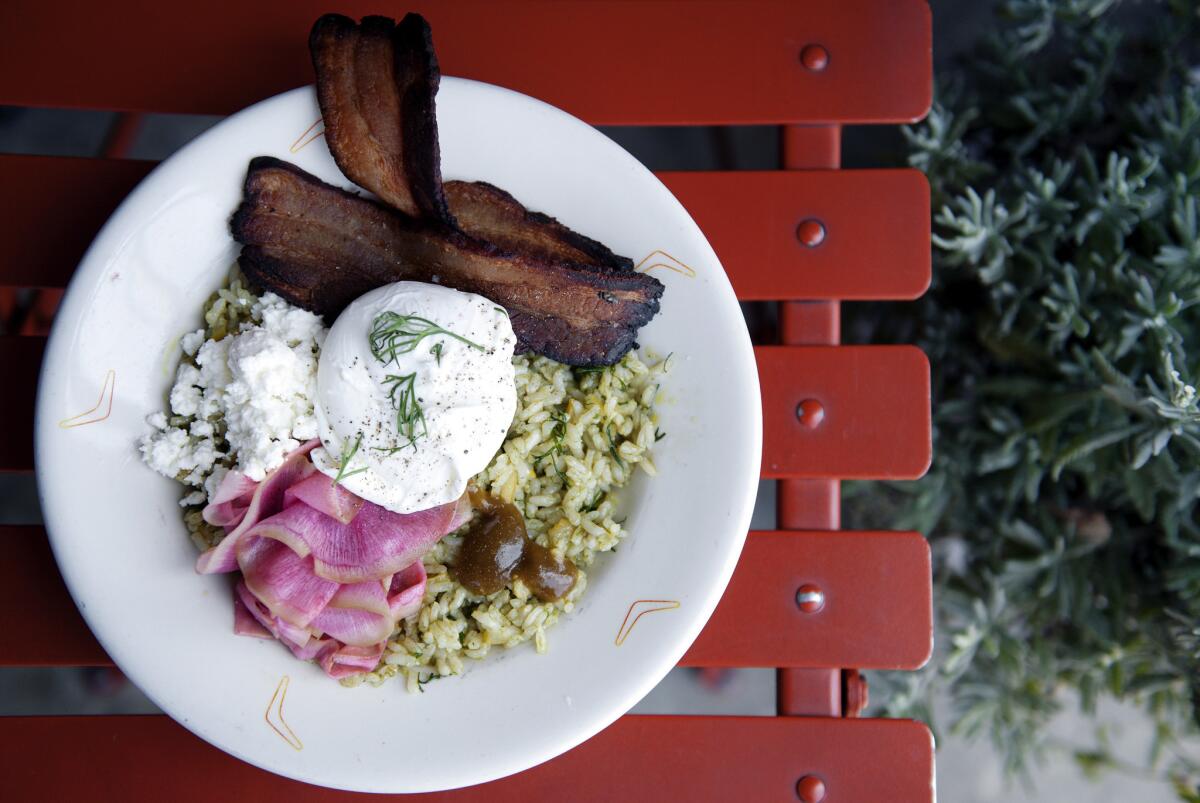
I think we’re all supposed to be over Sqirl now? It’s really hard to tell. The success of the breakfast-lunch cafe has transformed its bit of Virgil Avenue into a stretch of boutiques and vintage shops, and it’s the first place your cousin from Ohio wants to go when she gets into town. You can probably trace the popularity of grain bowls, avocado toast and $13 jam to Sqirl. The current predilections for the flavors of sorrel, turmeric, burnt bread and ricotta toast didn’t start with Jessica Koslow, but they may as well have. Who waits 90 minutes in line for a bowl of porridge? Still, the moment the braised chickpeas, the grilled cheese with tomato jam, the kale tabbouleh and the sorrel pesto rice hit the makeshift table, you’ve already forgotten what you were so sore about, and you regret only not having gotten a second matcha with almond milk for the road. Life is funny that way.
The Tasting Kitchen
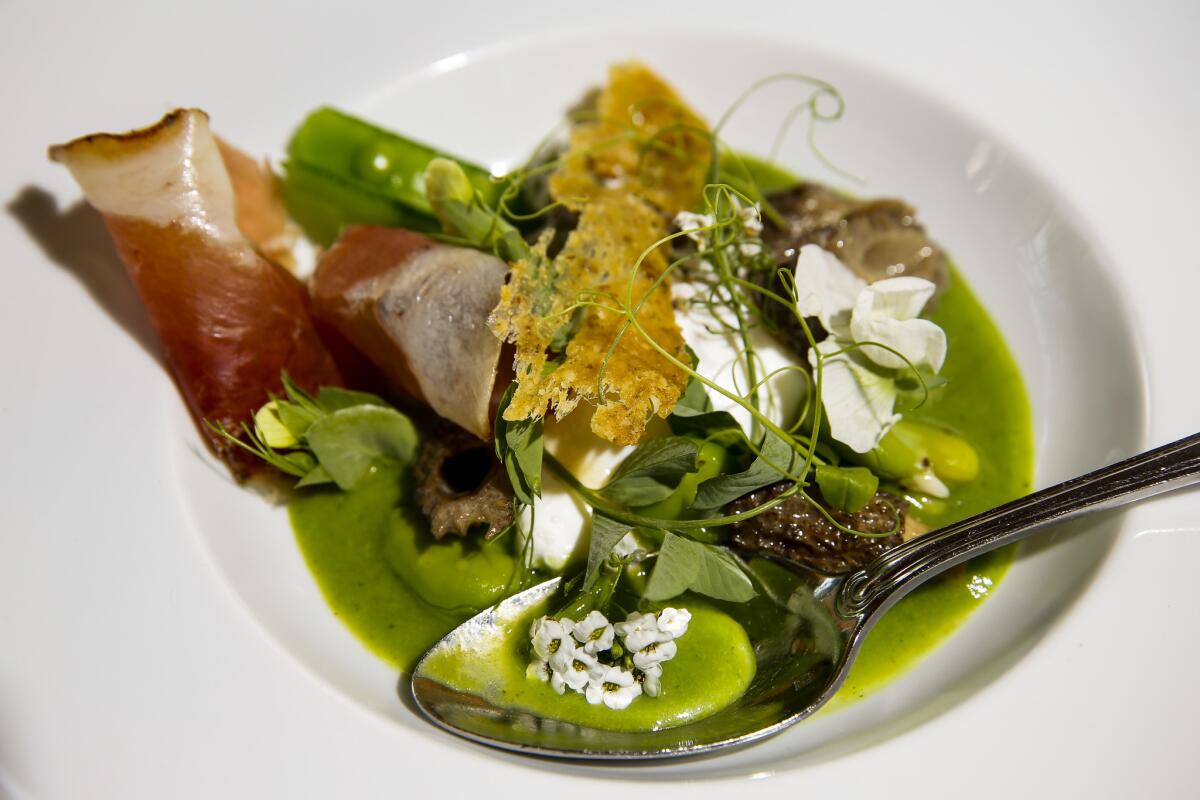
I may remark on this a little too often, but I continue to marvel that Tasting Kitchen actually exists. When it started, it felt like an act of performance art, Casey Lane and his friends coming down to occupy a failed Scandinavian restaurant like a hermit crab moving into a new shell. The menu, laid out as roughly as a suicide note, is no longer all in Italian, although it may as well be. But time and influence have a way of leveling things out. And the idea of basing dinner around toasted bread, of stickying chicken with reduced cider or serving rabbit with fideo isn’t avant-garde — it’s dinner. May Lane remain on Abbot Kinney for another 3,000 days.
Odys + Penelope
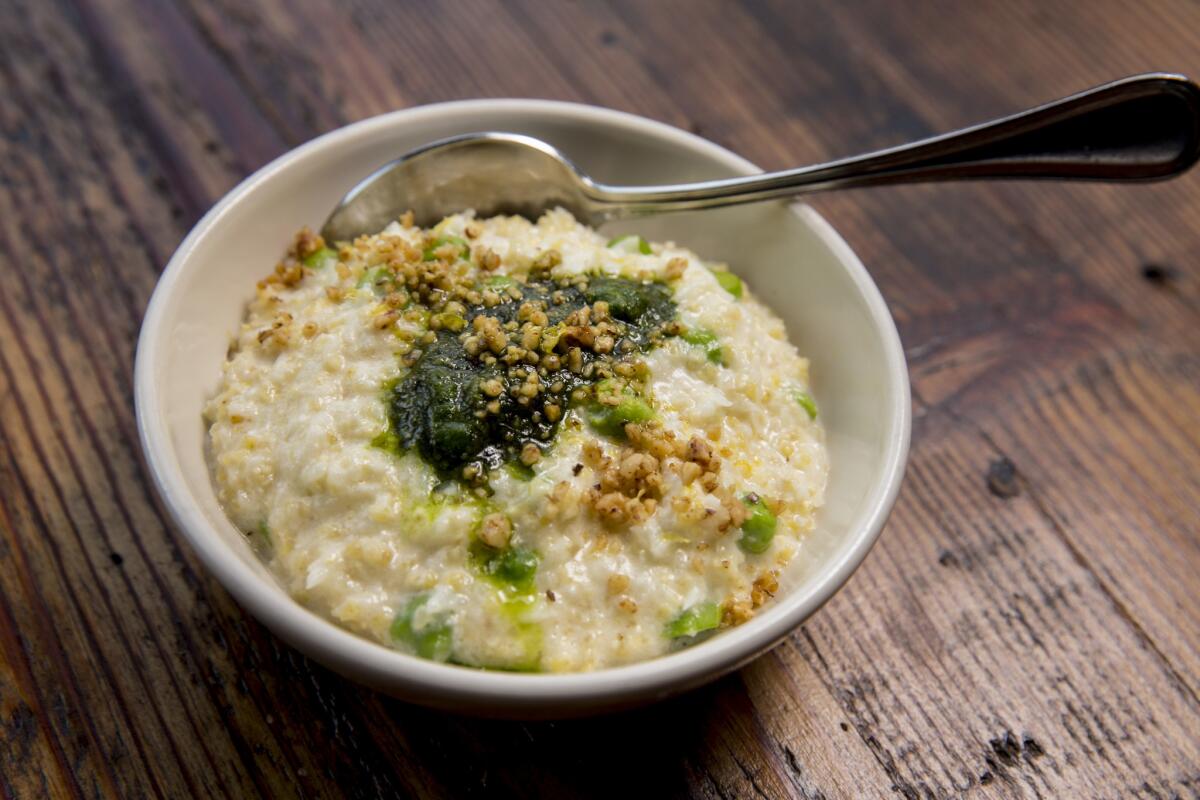
Quinn Hatfield riffs on the idea of churrasceria-style meat, slow-roasting cuts like skirt steak, short ribs and sirloin cap over embers and serving them at room temperature, although he dry-ages his beef, which is unthinkable in Brazil, and he serves it with things like béarnaise sauce or puréed carrots rather than the classic chimichurri. Still, as good as the bacon-wrapped chicken thighs may be, Hatfield may be even better with vegetables: broccolini with beet hummus and a creamy dish of cauliflower and millet painted with almond and basil that may be the best dish in the house — if you don’t count the undeniable perfection of the crisp yet crumbly rye crust on Karen Hatfield’s chocolate pie.
Sea Harbour
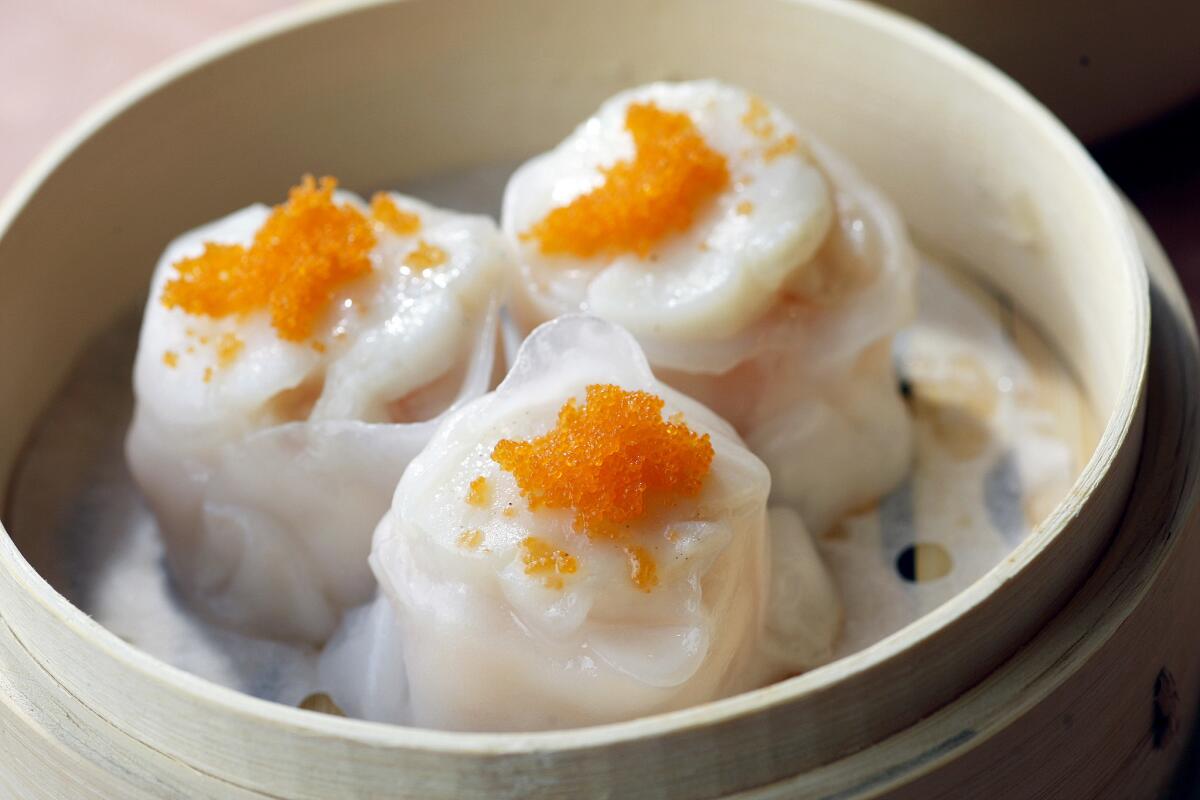
If you’re going to blow a paycheck on exotic fish and crystal crab or take the extended family out for dim sum, Sea Harbour has long been regarded as the most serious Hong Kong-style restaurant in the San Gabriel Valley. In practice, what this means is that some of the customers are splashing out on dried sea cucumber and bird’s nest while the others are enjoying merely glorious steamed prawns and roast squab — and everyone knows to come in the mornings for the dim sum, which remains the freshest and most imaginative in town.
Redbird
It is difficult, one imagines, to pull off a solid destination restaurant in the eclectic small-plates era, to satisfy the needs of steak-and-cab men as well as those of the guys slamming chicken-fried sweetbreads and Aperol spritzes at the bar, and the people secretly glad that the best dish in the house is the barbecued tofu. It looked like an impossible project when Neal Fraser announced his intention to transform the deconsecrated St. Vibiana Cathedral into a multi-tiered event space, but he succeeded — not least with this busy, big-city restaurant built into the rectory.
Jitlada
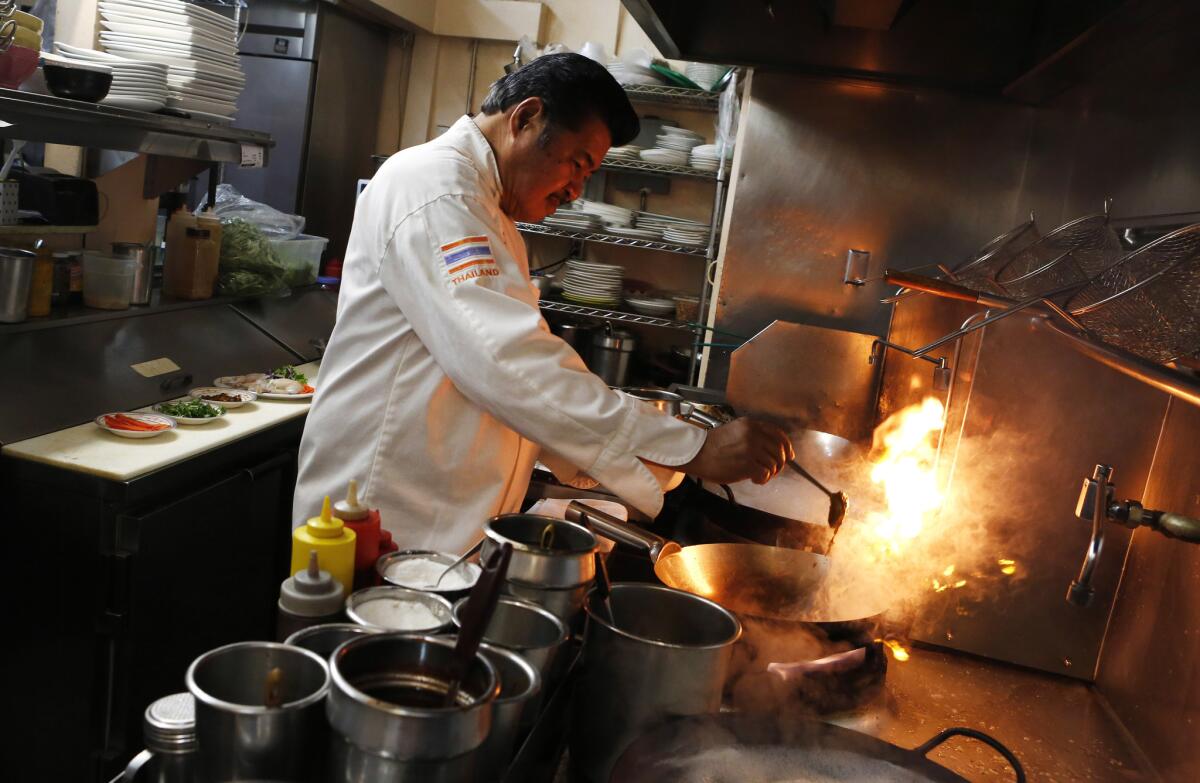
Jitlada, I will concede, can be a little taxing for a newcomer. There is a large menu of traditional Thai favorites and a sprawling photocopied addendum at the back that includes most of the Southern Thai specialties for which the restaurant is renowned. If you guess correctly and end up with something like khua kling and an acacia blossom omelet, you may be unprepared for the heart-stopping chile heat of the curry. You could play it safe with curried mussels and the crunchy salad made with fried morning glory, but you will have missed a bit of the wildness in Suthiporn “Tui” Sungkamee’s cooking. On the other hand, curried fish kidneys and fried silkworms with chile may not be your jam — but if you try to meet Jitlada halfway, you need never be bored.
Park’s BBQ
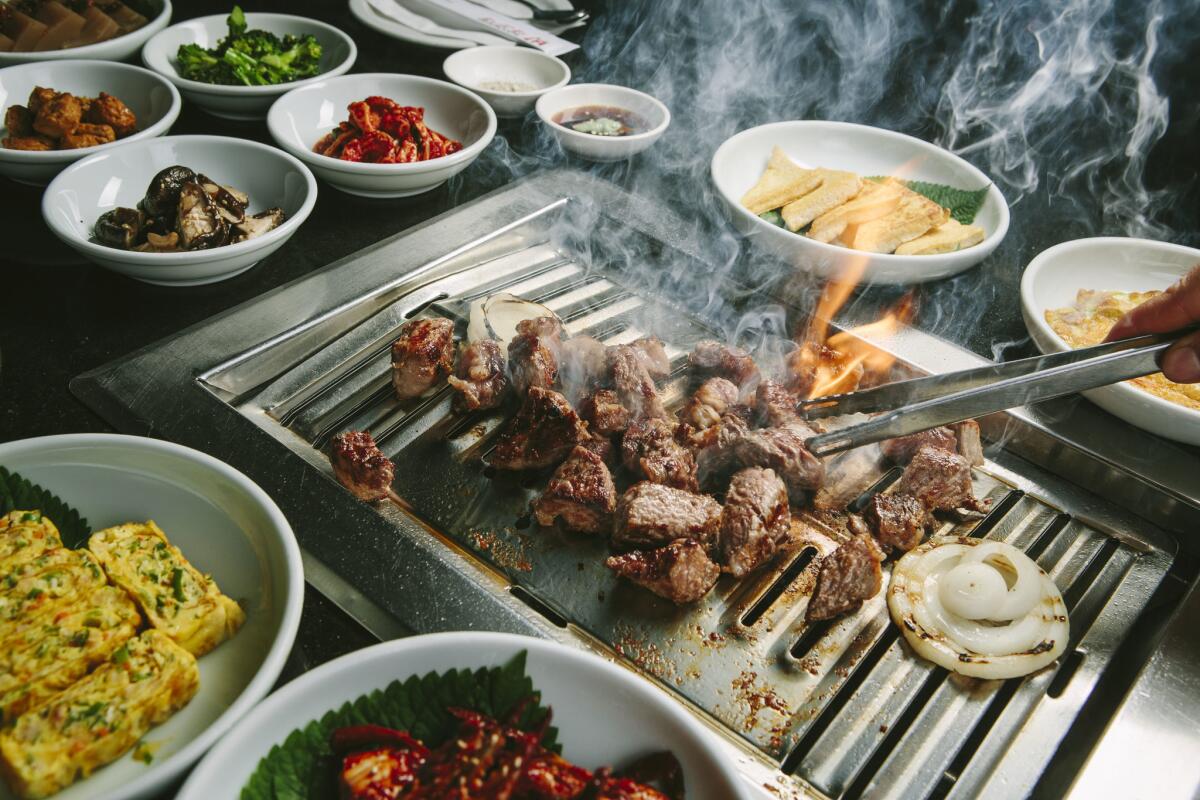
Park’s BBQ, a modernist dining room under the direction of Jenee Kim, was the restaurant that changed the Korean barbecue game: upping the prices, using prime and Wagyu beef instead of lesser grades, and introducing cuts like rare-breed pork belly and the super-marbled ribeye called ggot sal. Kim brought the quality of meat closer to places like Mastro’s and Cut. Park’s is no longer the only place in Koreatown using great meat, but its brand of Korean barbecue is still beyond compare.
La Casita Mexicana
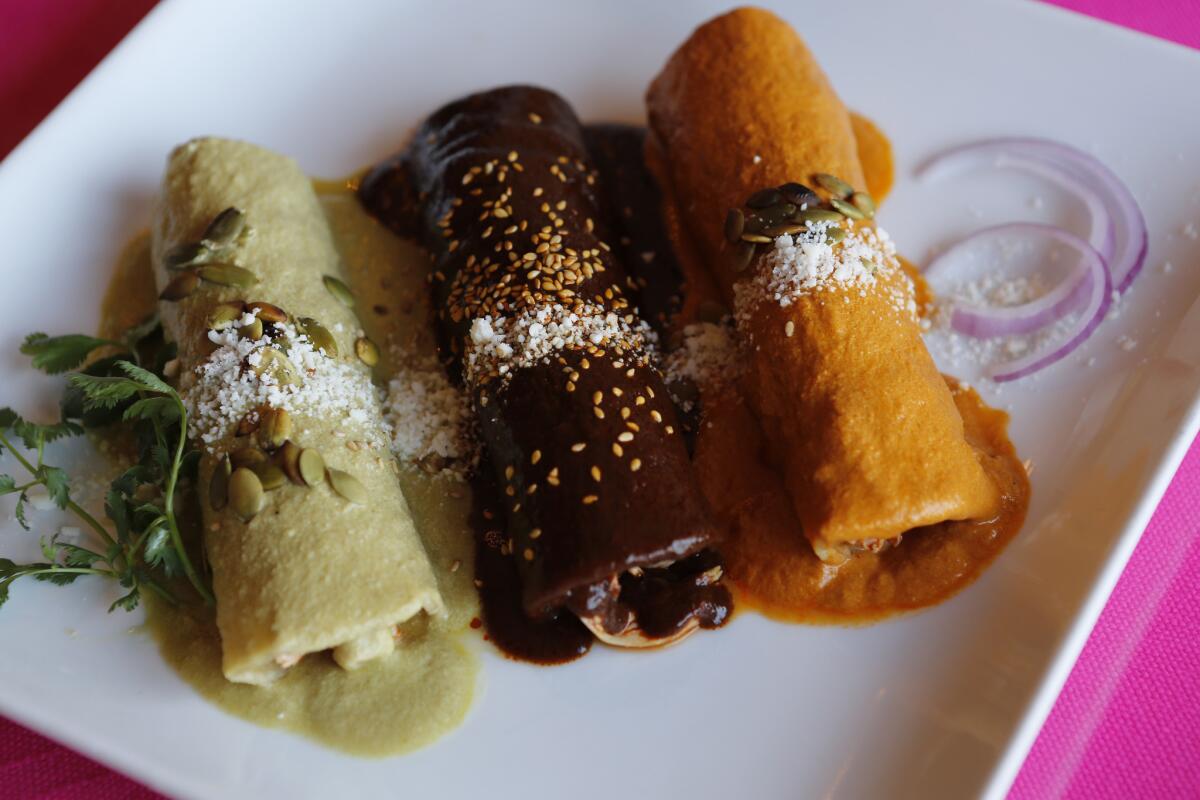
At some point during your meal, you start to realize that you may be eating enchiladas, but they are wonderful enchiladas, made with thick, freshly made tortillas, slicked with unusually delicious chile sauce, stuffed with cotija cheese better than you are likely to find in your local supermarket. You may have started your meal with more cheese roasted in banana leaves, taquitos bathed in mole and pepian sauces or guacamole spiked with tequila. There is the dried beef called cecina, beef shank braised in a spicy adobo sauce, and chiles rellenos with cactus and mushrooms; fish steamed in corn husks with adobo or braised with chile morita; and a sweet, rich version of chiles en nogada striped white, green and red like the Mexican flag. If you manage to wake up early enough for breakfast, the chilaquiles, fried tortillas softened in salsa or mole, are among the best in town.
Brodard Chateau
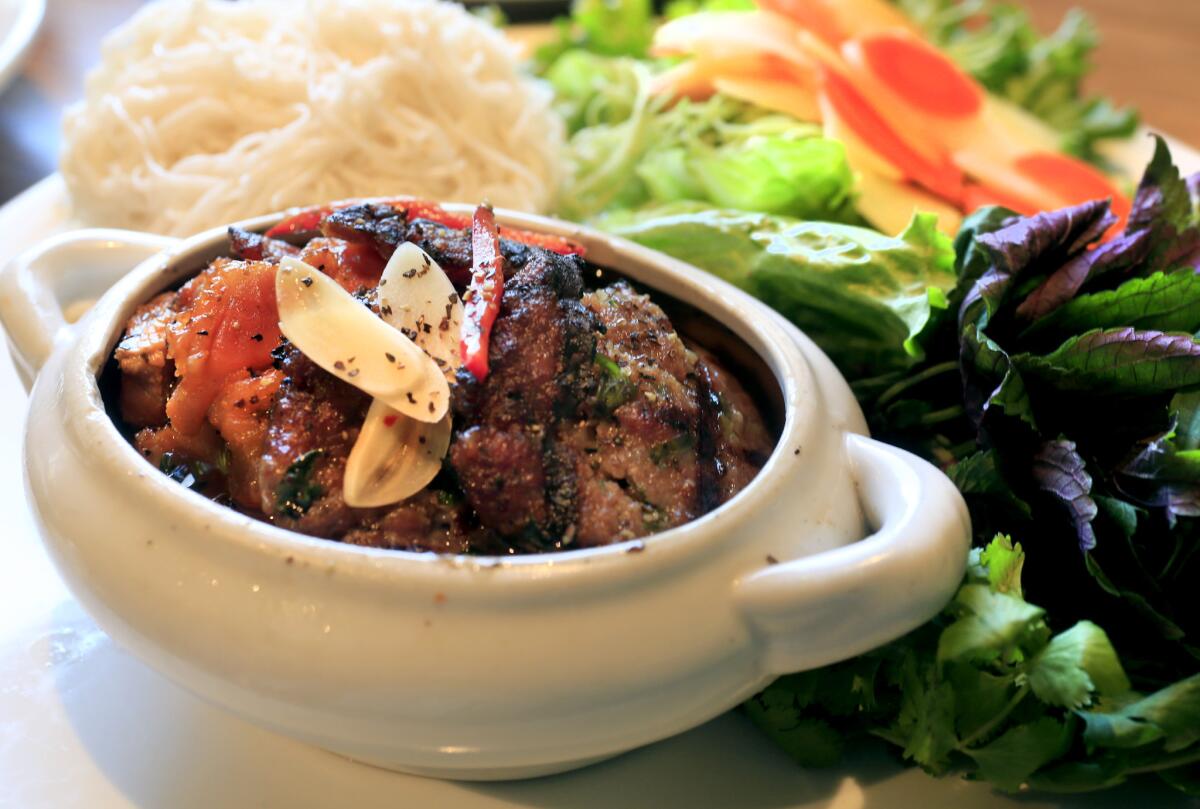
Brodard Chateau is probably the swankest restaurant in Little Saigon, a converted Victorian mansion marooned on a freeway frontage road. The lighting is soft, and you can get a rack of lamb should you want one. Still, you are here for one reason: The wait for a table at the original Brodard can stretch as long as two hours on busy weekends. The restaurant serves really good versions of the grilled pork noodles President Obama shared with Anthony Bourdain in Hanoi; sautéed clams with spongy sliced elephant ear stem; and the coconut-sweetened mini-crepes called bánh khot. But if you forget to order nem nuong, the waiter will stand patiently by the table until you tell him how many orders you would like.
A.O.C.
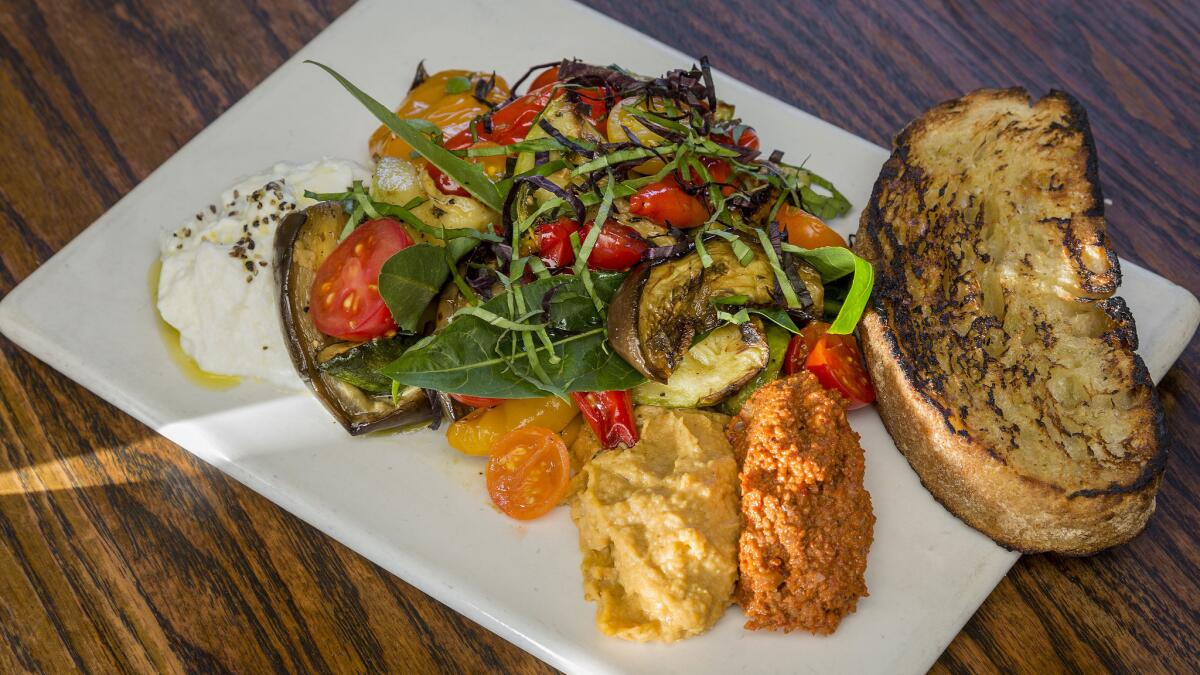
If we’ve lived through a battle for L.A.’s restaurant soul, Suzanne Goin and her business partner and sommelier, Caroline Styne, have won. And as good as the food is on A.O.C.’s handsome patio — stuffed quail, grilled artichokes, smoky wood-roasted clams with green garlic, and a crisp-skinned roast chicken with bread salad inspired by the late Judy Rodgers — what comes through is the ease, the small happiness of drinking wine in the garden with your friends.
Kobee Factory & Syrian Kitchen
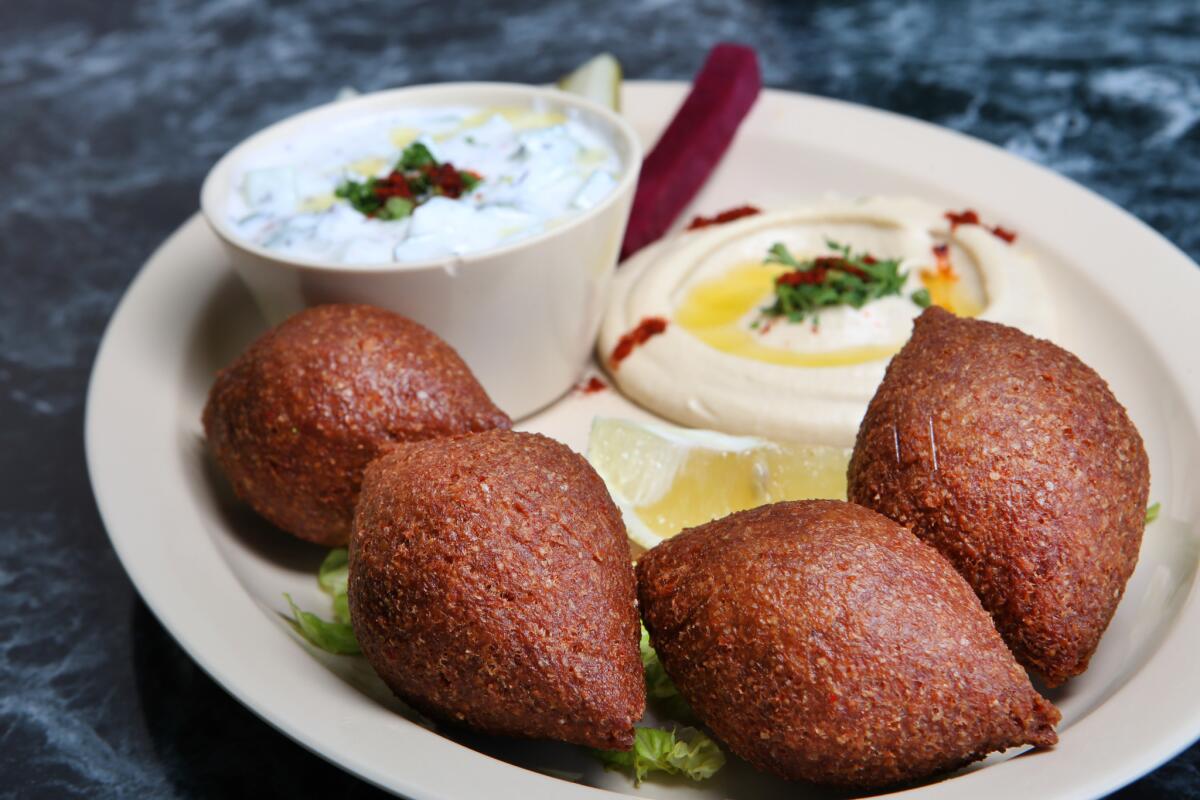
When Waha Ghreir moved here from Homs, Syria, 40 years ago, she swears she did not know how to so much as crack an egg. But her kobee, delicately spiced capsules stuffed with bulgur and chopped meat, is fairly extraordinary, served either grilled or fried, with a compelling illusion of lightness when the thin, supple crust dissolves under your teeth. The stuffed lamb intestines look like a Halloween nightmare, but turn out to be delicate, mild rice sausages in a cinnamon-scented broth. If you show up at breakfast time, there is one of the best versions of fateh in town, a pita submerged in a bowl of chickpeas, tahini and yogurt. And her mjadara, bulgur cooked with lentils, is alive with the fragrance of toasted onion and as satisfying as any plate of beans and grain you’ve ever tasted. It is a plate that could sustain a civilization. And it has.
Connie and Ted’s
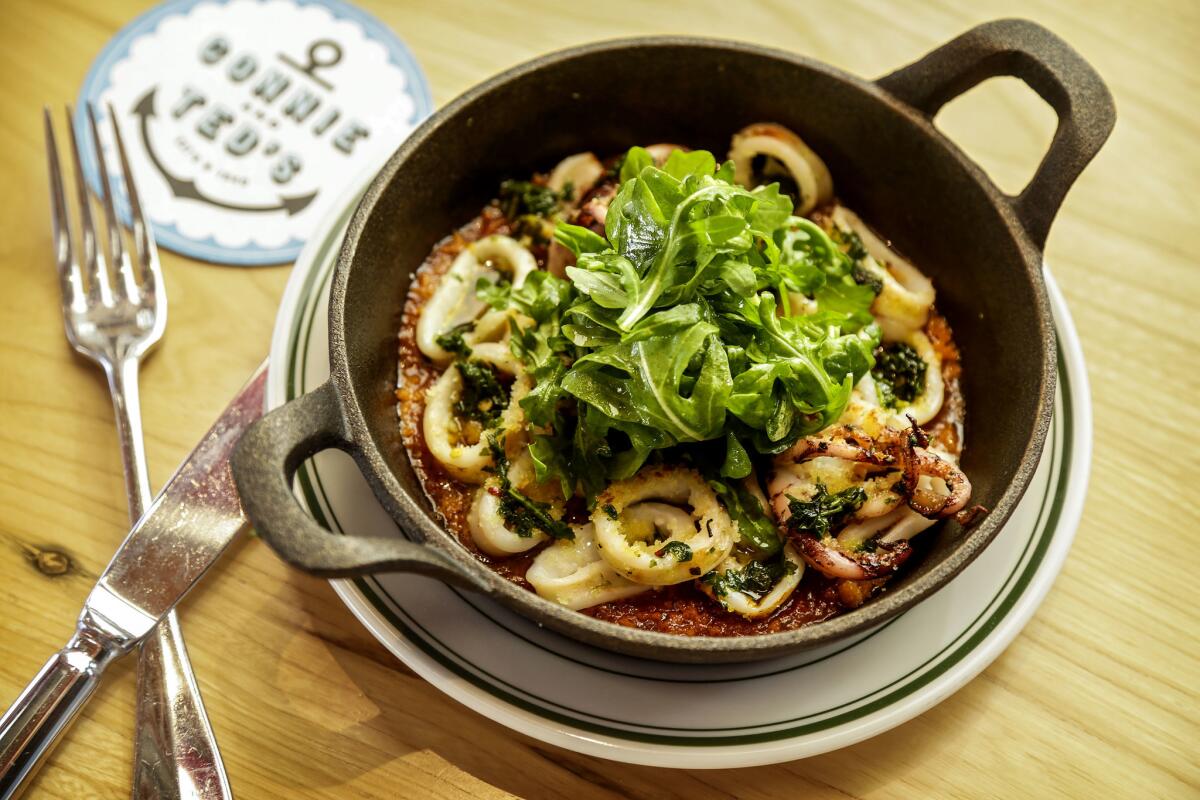
Sometimes it seems like a miracle that Connie and Ted’s even exists, a swooping post-Googie palace of metal and glass set down in the busiest stretch of West Hollywood, serving a New England expat’s fever dream of a seafood menu. Should stuffies, steamed littlenecks, fried bellies and briny Rhode Island chowder even exist in this clam-deprived part of the world? You can get passable lobster rolls from trucks now, but can you get dense little clam fritters, freshly baked Parker House rolls, and as many kinds of oysters as there are moons of Saturn? Have you ever had Indian pudding within 2,500 miles of this ZIP Code? You are going to drink a lot of white wine here. Make sure someone else is driving home.
Adana
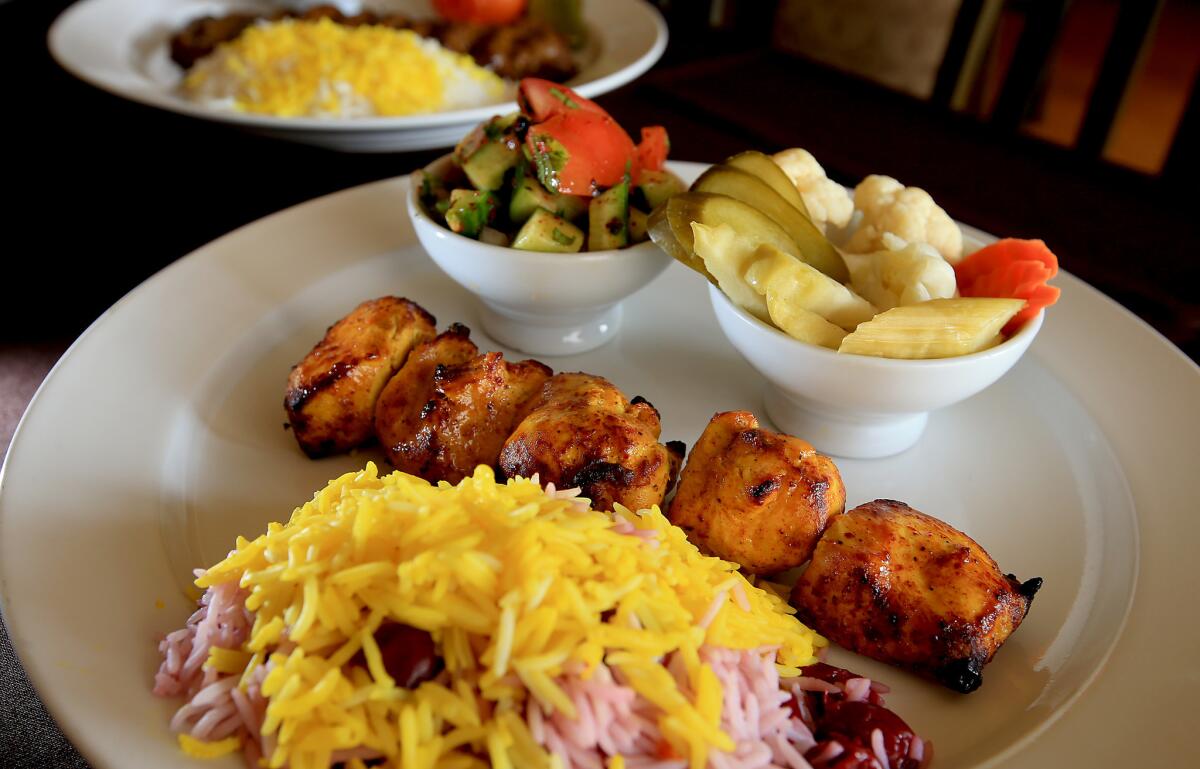
If you want to understand Adana, a Middle Eastern restaurant in an industrial corner of Glendale, you should probably order what the menu calls the cheese platter — slabs of milky feta, fragrant heaps of mint and purple basil, crisp wedges of raw onion, and a spicy paste with olives. You wrap them in scraps of pita, separately or in combination, sip mint tea or a yogurt drink with cucumber and dill, and chat with your friends. You are in a contemplative space, in a dining room that looks as if it were spirited from a country house in the Caucasus. There is minted cold soup with yogurt and barley to consider, or pilafs flavored with sour cherries or orange peel and almonds, and what may be the only chicken kebab in town worth considering.
Little Sister
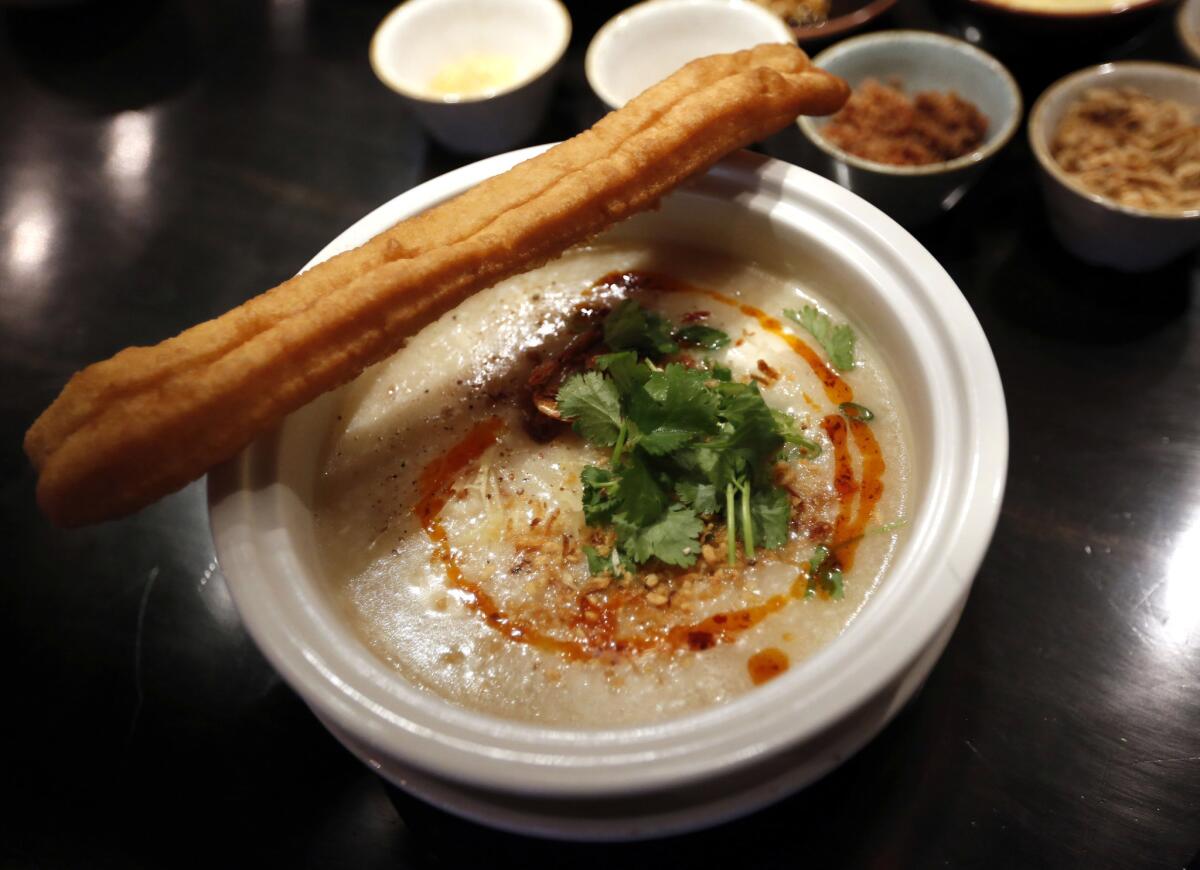
Is Tin Vuong among the current rank of anti-fusion chefs? His cooking at Little Sister does lean toward a certain rude vitality, sometimes deliberately unfinished. The dipping sauce Vuong serves with his dense, salty imperial rolls is powerfully sour. And when he does introduce Western flavors into his proto-Vietnamese cooking — brown butter in the beef dish bo luc lac, salt cod in the fried rice — it often has the effect of making them more rather than less Asian. Even the lemongrass chicken has been transformed from a stir-fry to a crunchy bar snack, ideal for easing down that third glass of beer. The Manhattan Beach restaurant is a happy, beachy place with gangsta rap on the sound system and Black Flag lyrics painted on the walls; the newer Los Angeles Little Sister is a little buzzier, more of a bar thing, and has both congee for breakfast and killer bánh mìat noon.
Mian
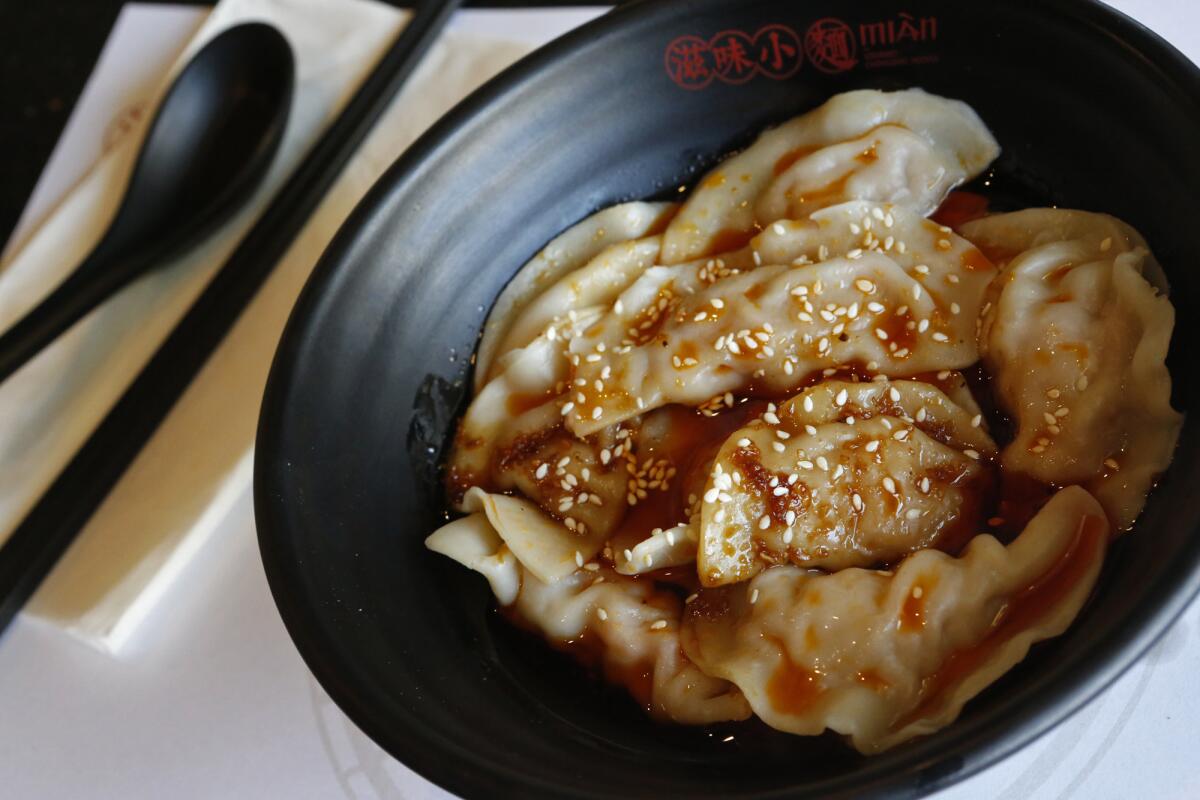
The flavors are bright and clean, informed as much by the sour funk of Sichuan pickles as by pure chile heat. The noodles themselves, served in or out of broth, paved with ground pork and scallions, perhaps enriched with a fried egg, have the distinct chewy pull of good Italian pasta. (I like the hot and sour noodles.) These are noodles with a mean streak, a potent lashing of hot chile and oil, laced with just enough Sichuan peppercorn to numb the pain of the pure chile heat. If you want an extra jolt of starch, try the zhajiangmian laced with a handful of soft peas imported from Chongqing. And try the dumplings called chaoshou too.
Locol
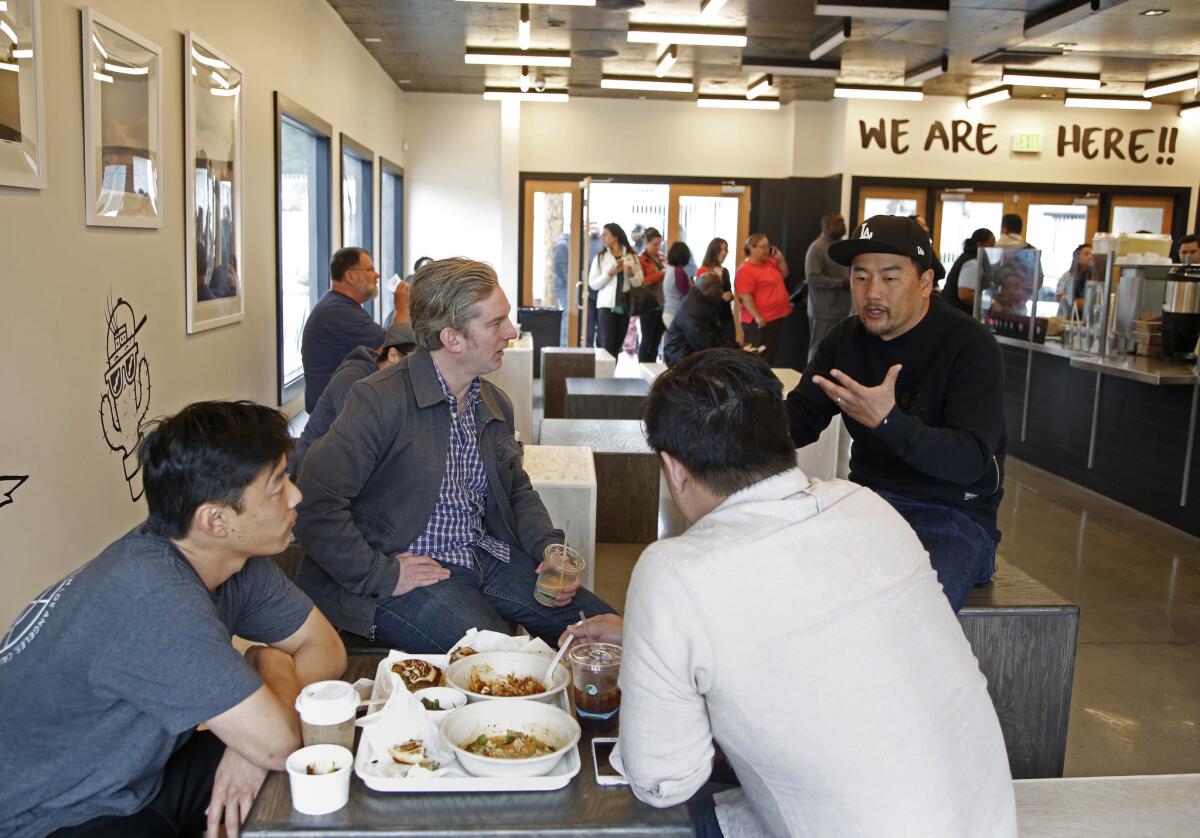
The Watts quick-service restaurant Locol was the most important restaurant to open here in 2016. The Times named it Restaurant of the Year. Food & Wine listed it among its best new restaurants. But while the prospect of Kogi’s Roy Choi joining forces with the Michelin-starred modernism of Bay Area chef Daniel Patterson is intriguing, Locol’s food is less an experiment in culinary creativity than it is an attempt to fashion sustainable, lower-fat, lower-salt, affordable versions of dishes already popular in the neighborhood it serves. The restaurant is staffed by people who live in Watts. Locol’s cooking is less a replacement for fast food than a better version of it. The burgers and sandwiches are served on soft, griddled buns developed by Chad Robertson of the famous San Francisco bakery Tartine. The food feels handmade. And while Locol may be only one version of the future of food, it is one that we all can live with: good food for all.
Grand Central Market
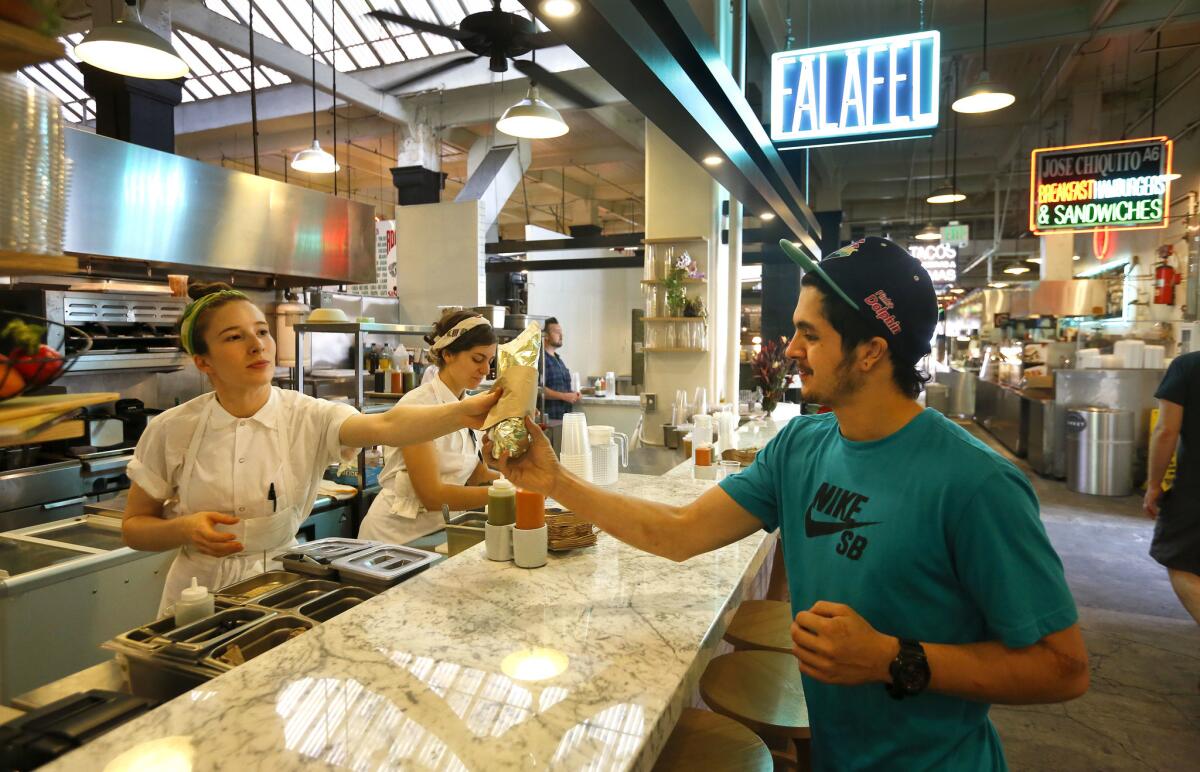
There are stalls dedicated to currywurst, handmade pasta, peanut butter sandwiches and vegan ramen. People still drive from across town for the grass-fed meat at Belcampo, the smoked fish at Wexler’s Deli, the Normandy butter at DTLA Cheese and the loaves at Clark Street Bread. The breakfast queue at Eggslut is still as mind-boggling as its coddled egg on mashed potatoes. And it is still impossible to imagine downtown without it.
Coni’Seafood
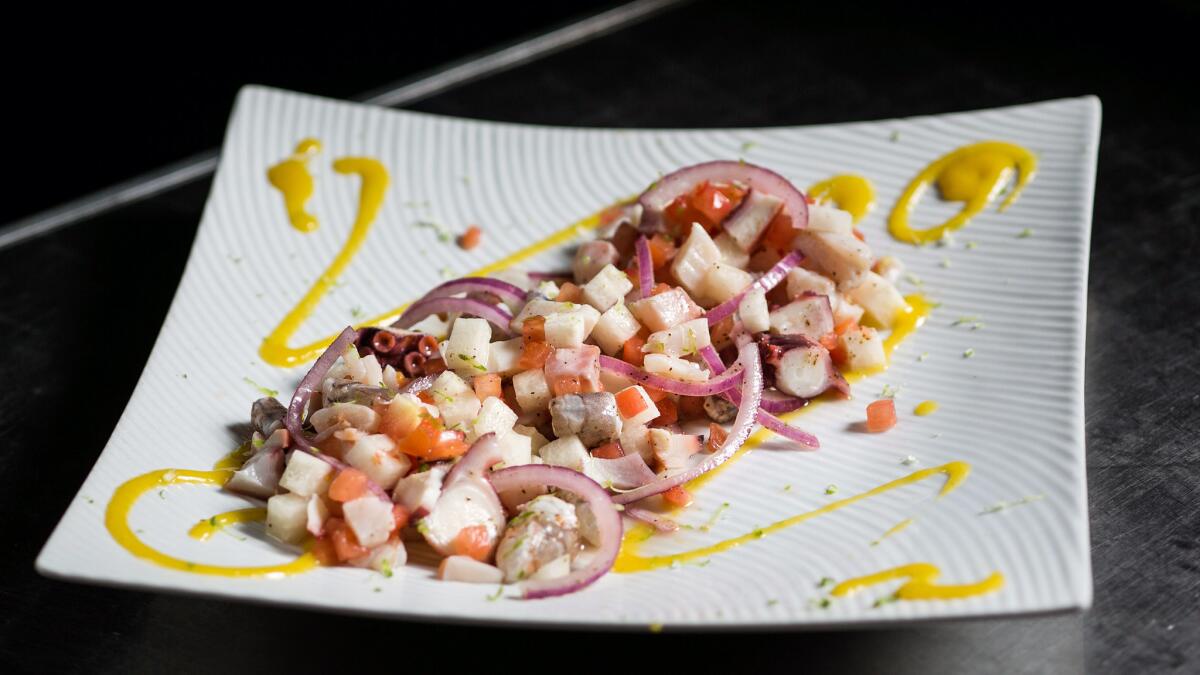
Without anyone quite noticing it, Colima-style pescado zarandeado became one of the emblematic dishes of Los Angeles, a broad, thin fish, dabbed with some mixture of citrus, spices and mayonnaise, roasted slowly over a smoky fire. A lot of the restaurants serving pescado zarandeado are run by relatives of Vicente “Chente” Cossio, who still runs the original Mariscos Chente down in Inglewood. If you follow the confluence of food and social media, this fish may have been bubbling through your feeds for more than a decade by now. But Connie Cossio of Coni’Seafood may be the most gifted cook in the family, skilled not just with pescado zarandeado but with crisp smoked marlin tacos, shell-on shrimp fried until they become as bent and brown as insects, the ceviche marinero studded with crunchy green mango and impeccable shrimp aguachile in a sharply spicy citrus marinade.
Kogi BBQ
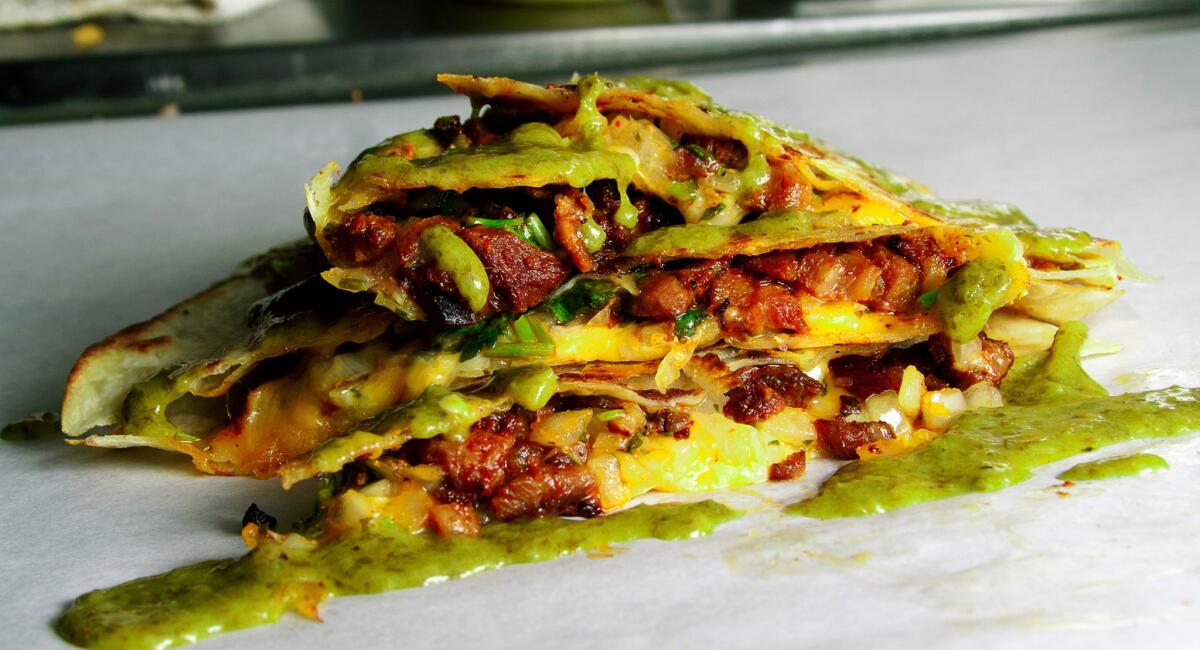
If in 2008 you were going to pick the local chef who would be most active on the world food circuit, you probably wouldn’t have chosen the guy who sold Korean tacos out of a truck. Yet in the Kogi truck (there are now several), Roy Choi managed to jump-start both the food truck movement and the importance of social media to the modern kitchen, as well as the exacting, fermentation-forward fusion cooking that dominates L.A. kitchens at the moment. Kogi is cheap, delicious and unmistakably from Los Angeles, food that makes you feel plugged into the rhythms of the city just by eating it. The grilled short rib tacos taste like home.
Guelaguetza
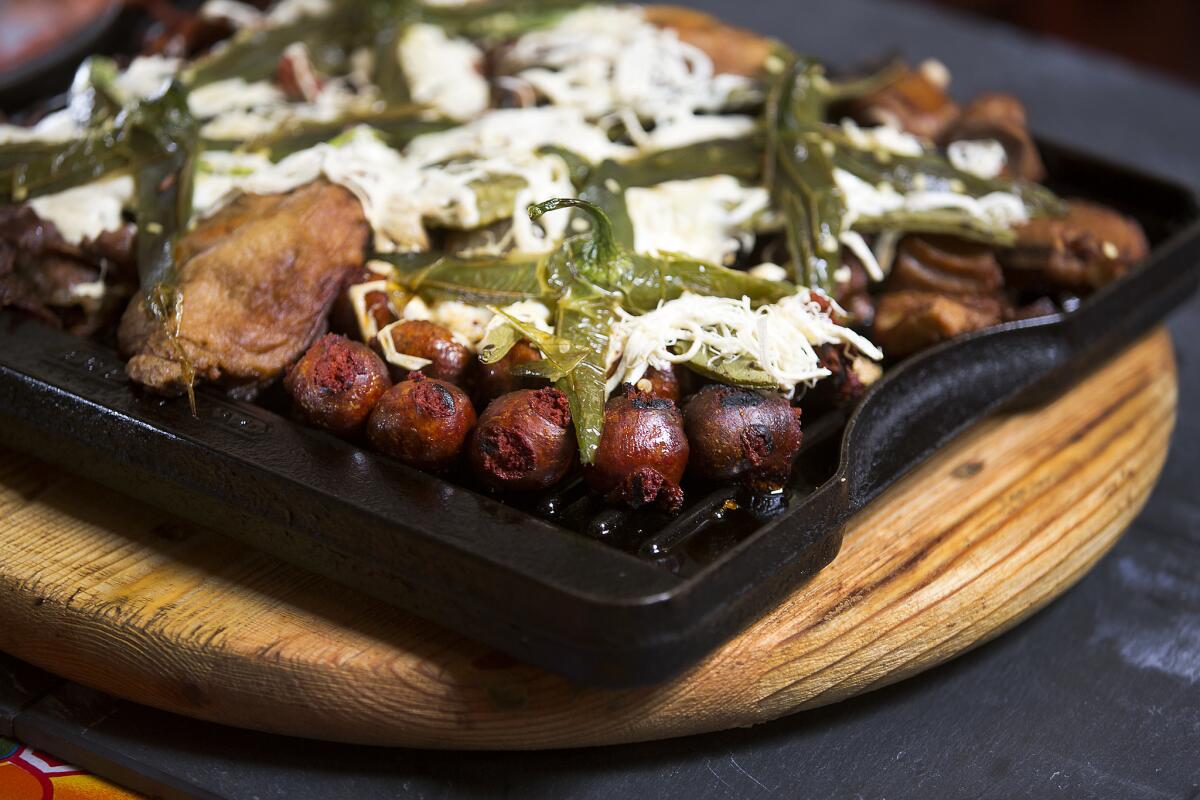
Guelaguetza is home to L.A.’s best enmoladas, ace micheladas, an enormous selection of tequila and mezcal, and a theater-size projection screen. The tlayudas, imported table-size tortillas smeared with black beans and melted lard, are as good as any pizza you’ve ever eaten at 7 in the morning, and the tiny, ruddy globes of chorizo are much better. El Tri scores. You scream. There are a lot of Oaxacan restaurants in Los Angeles now, and it is possible to debate the merits of the mole coloradito at one and the molotes at another, but Guelaguetza remains the most accomplished Oaxacan restaurant in the United States.
Manhattan Beach Post

Everything is portioned for sharing — cheese-crusted Brussels sprouts, super-sized French fries, soft-shell crab with nectarines. The one dessert that’s never come off the menu is the Elvis, with chocolate pudding, peanut butter and bacon brittle. And pretty much everybody orders the bacon-cheddar biscuits that chef David LeFevre learned from his mom when he was in junior high. It’s the kind of eating you can indulge in only after an afternoon of beach volleyball.
Rice Bar

If Guerrilla Tacos is Exhibit A, Rice Bar is Exhibit B, manned by Charles Olalia, who left his job as executive chef at Patina to open this seven-stool lunch counter downtown, a miniature palace of Spam and fried egg, pancit noodles, and homey Rice Krispies treats. The menu is mostly rice bowls, topped with things like crunchy dried anchovies, braised beef or sweet longanisa sausage, all throwbacks to Olalia’s Filipino childhood, garnished with pickles, and prepared as carefully as you might expect from a chef who trained at the French Laundry and Guy Savoy.
Bellwether
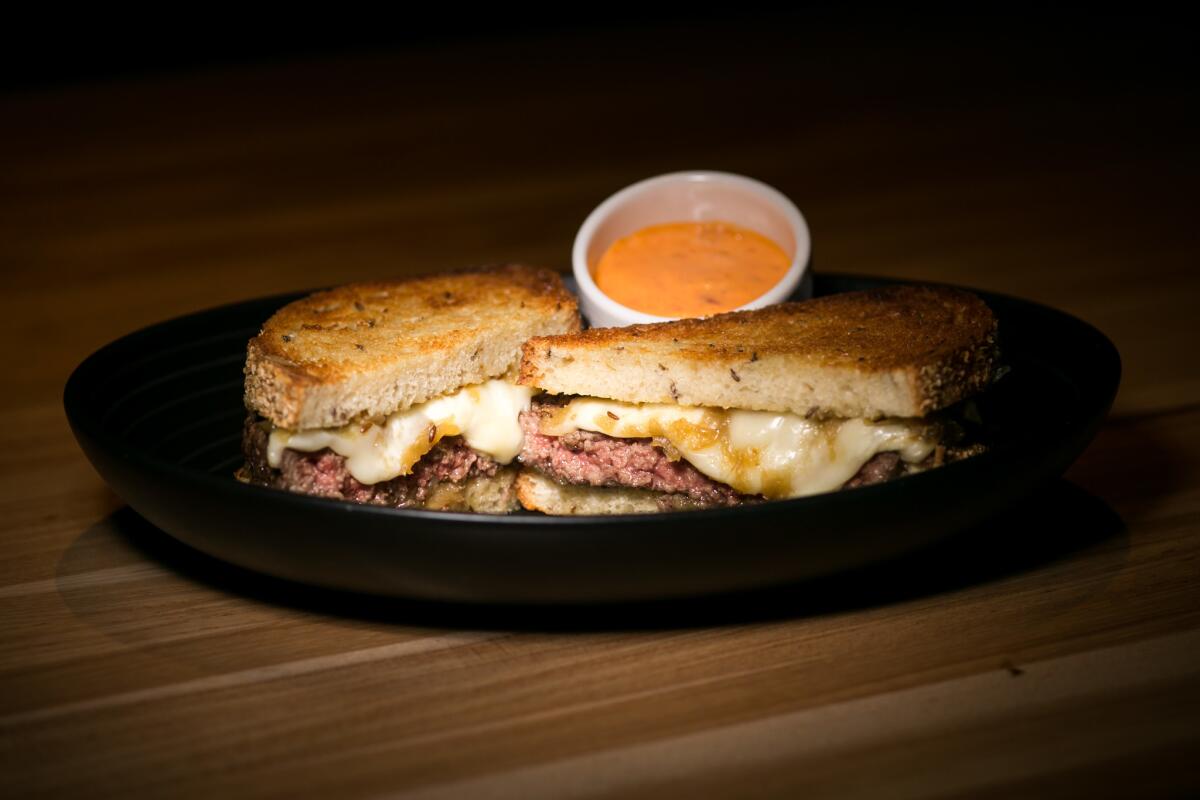
When acquaintances bring up the Bellwether, Ted Hopson and Anne-Marie Verdi’s American bistro in Studio City, they tend to mention the patty melt. And while you may personally be more interested in the charred octopus with preserved lemon, the fried squash blossoms with anchovy and tomato or the tempura cauliflower in a Thai fish-sauce vinaigrette, the fixation is easy to understand. It’s not easy to find something like a patty melt in a restaurant like this one, and it happens to be served on super-crisp rye bread with pools of melted Taleggio cheese and sweet caramelized onions. The perfectly crisp steak fries are the end result of a three-day process. The bar may specialize in infused this and macerated that, but it is happy to serve you a Manhattan or a Negroni.
Colonia Publica
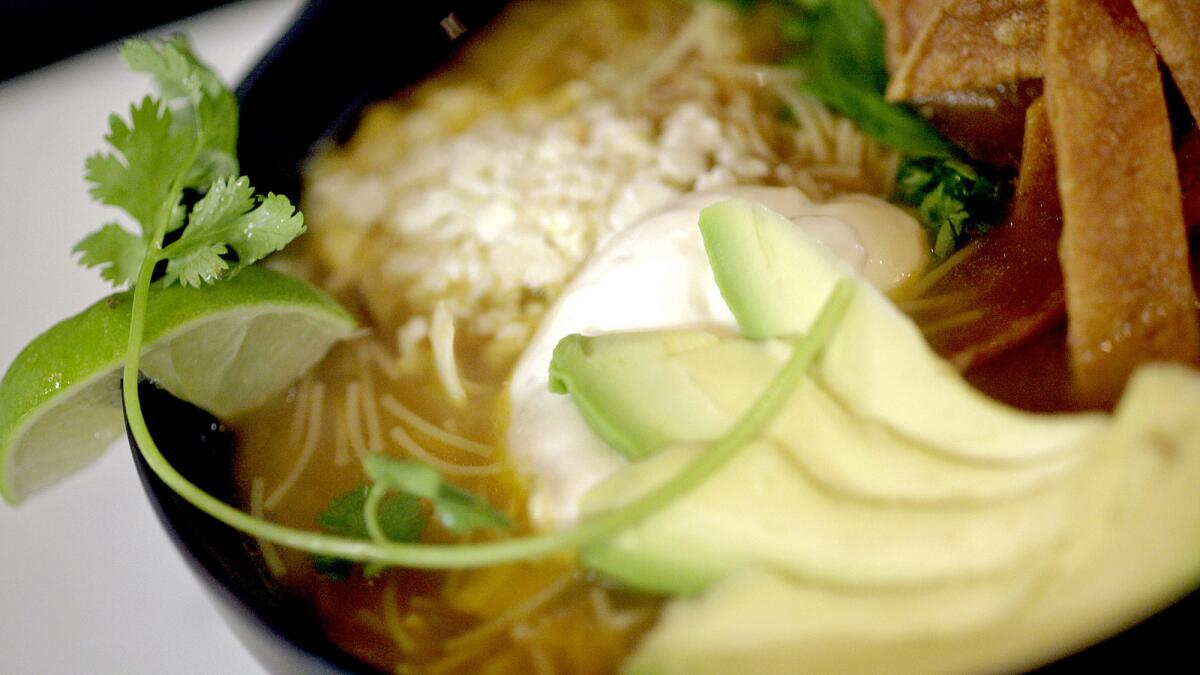
Ricardo Diaz is at the center of Uptown Whittier’s pocho culinary renaissance. (He was also the co-architect of Guisados, Tacoteca and Cook’s Tortas.) He’s planning a massive beer-centered restaurant in the building that used to house Richard Nixon’s law offices, and he is the maestro of the elaborate tacos and antojitos at Colonia Tacos Guisados and Bizarra Capital. The noodle bar Colonia Publica is devoted to the spicy beer-plus cocktails called micheladas and to fideo, the ultimate dish of Mexican home cooking; a toasted-noodle soup strongly identified with mom and Thursday nights in front of the TV. And when you settle into a booth, you are handed a checklist asking exactly what you would like to put into your soup. You can stage little competitions at your table, seeing who has managed to compose the tastiest bowl.
Attari Sandwich Shop

The only respectable Iranian food, any expat will tell you, can be found only at her mother’s home. And it tends to be true — the vast diaspora of Iranian restaurants in Los Angeles specializes mostly in simple rice dishes and kebabs, which are delicious but no more related to the intricacy of Iranian cooking than a plate of steak-frites would be to the marvels of the French table. Attari is not a temple of Iranian cuisine — it’s a simple lunch spot in a shady Westwood patio, although sometimes it does seem like a bit of Tehran café life circa 1975. The restaurant is famous in Tehrangeles for the dense vegetable soup called osh. The jam-thick stewed eggplant, kashke badjeman, is nice. But on Fridays, the crowd is there for ab-goosht: a plate of mashed chickpeas and lamb served with a basket of lemony herbs, thin flatbread and a cup of their essential juices to enjoy as soup.
Irenia
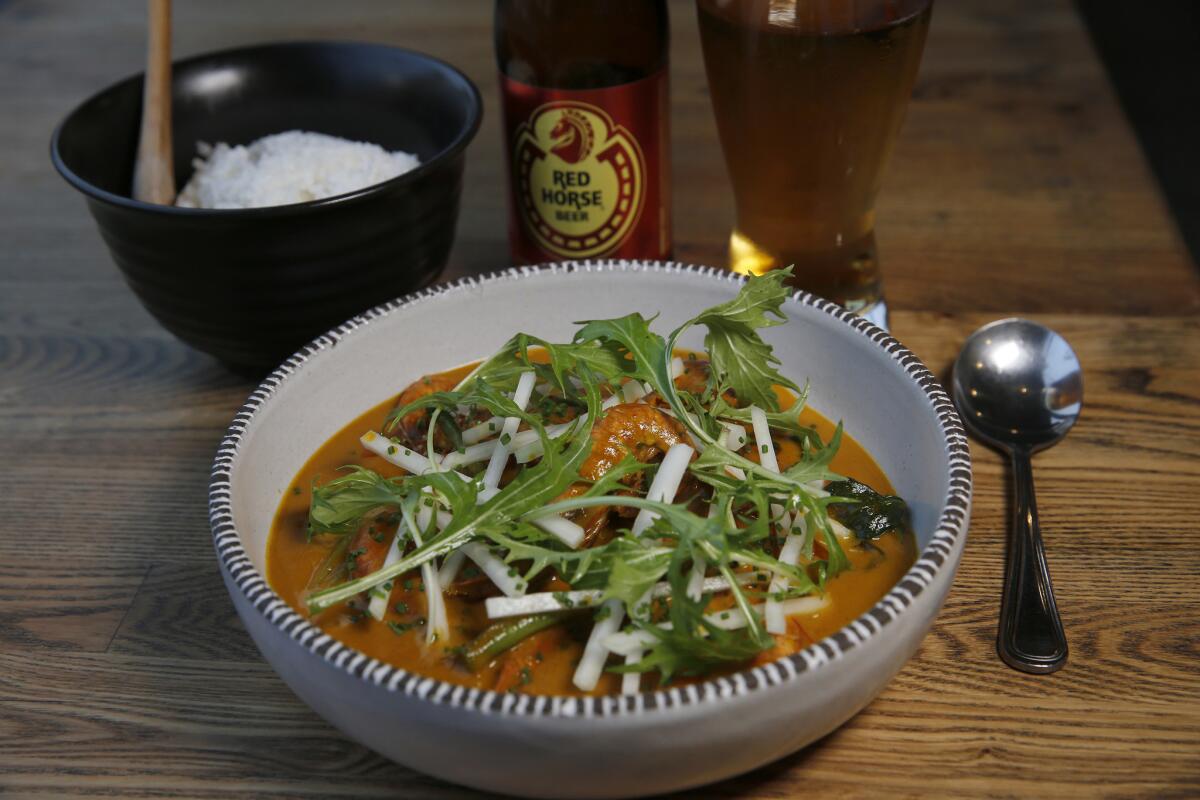
It’s cheffy Filipino grandmother food, really, things like kare kare made with charred cauliflower instead of oxtail, the livery stew dinuguan transformed into a suave roast pork shoulder, and sweet, soft pork belly adobo is draped over what in an Indian restaurant you would call a mung bean daal. But you are going to want at least a slice of Irenia’s lovely ube brown sugar pie. It’s like a Southern chess pie on a Filipino vacation.
Tsujita
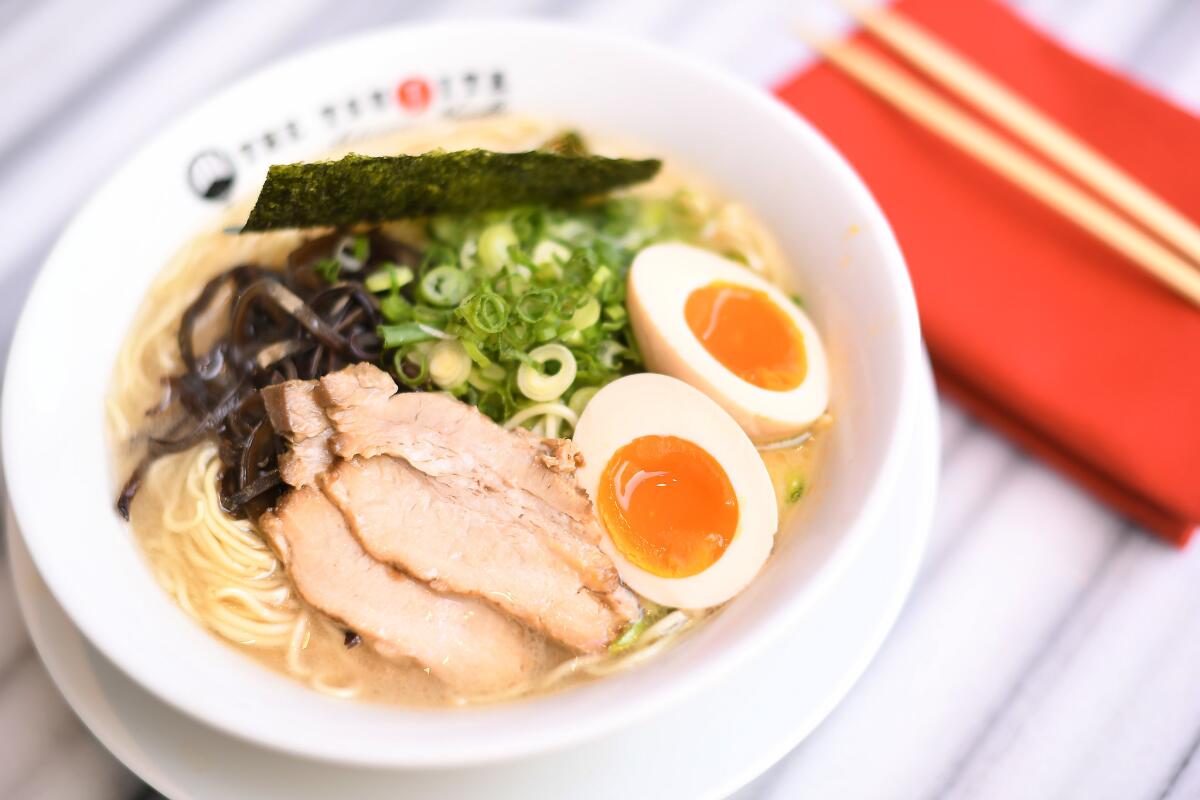
The king of tonkotsu ramen in Los Angeles is Tsujita, a branch of a well-regarded Tokyo noodleshop that has clotted traffic on Sawtelle Boulevard since it opened. Tsujita’s broth is obscenely rich, made from pork bones boiled for a full 60 hours. Your lips stick together. The temperature of the soup is just below boiling. And if you crave intensity, the tsukemen is even more hardcore — the noodles have the tensile strength of hand-thrown Lanzhou mian, and the broth, enhanced with a bit of seafood, is served on the side as a dip, reduced to a consistency just this side of syrup. Good times!
Gjusta
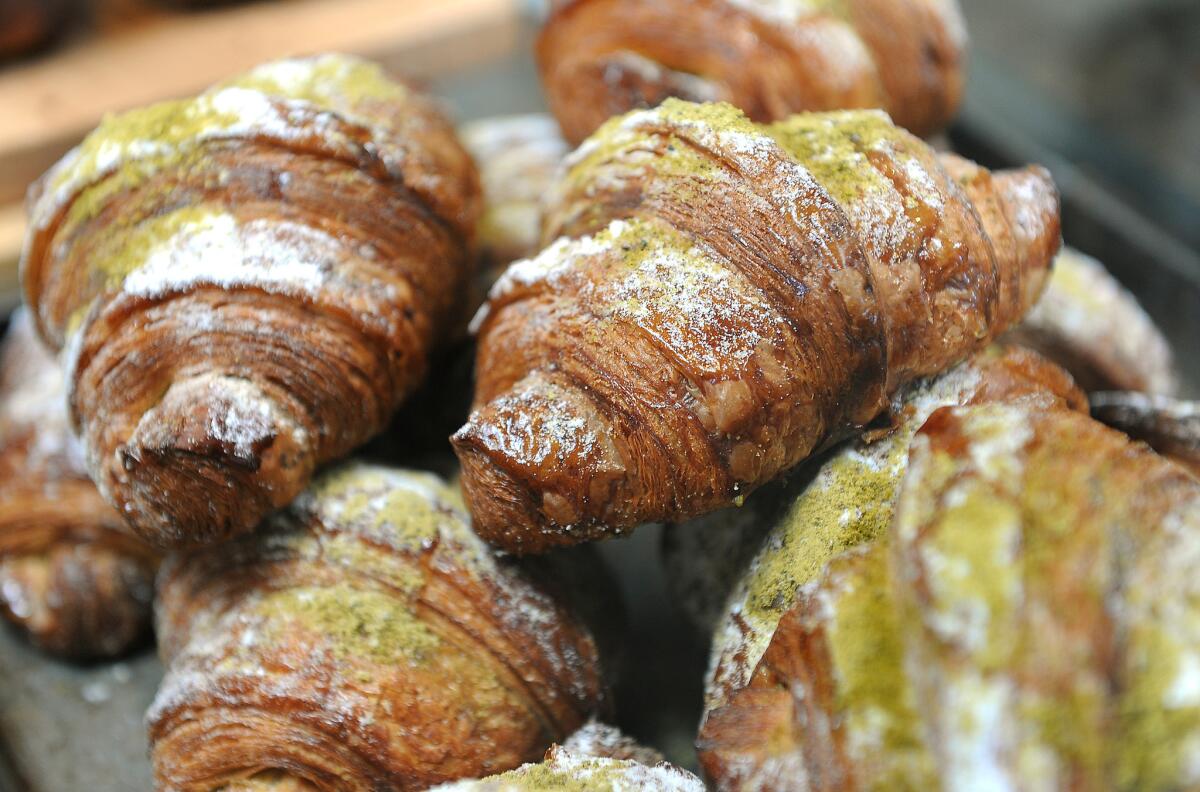
If you ache for the bakery’s rustic pastries or burnt-crusted loaves, among the very best in Los Angeles, you resent the difficult parking. If you are fond of the tagliatelle with bottarga, the grilled octopus or stunning house-smoked fish, you grumble at the tight seating on the patio, perhaps yearning for the restaurant’s earliest days, when you either sat on milk crates or you didn’t sit at all. Gjusta, the gawky little sister to Travis Lett’s Gjelina, serves the same function in Venice that a first-rate deli might: serving grain bowls and croissants in the morning and fried chicken at night; great sandwiches; and takeout elegant enough to serve as the centerpiece of a dinner party, although everybody is going to know where you got the cauliflower with capers.
Garlic & Chives

The concept of Asian American fusion gets tossed around a lot in Southern California. But the Little Saigon small-plates bistro Garlic & Chives couldn’t be more Vietnamese, from the roasted peanuts and slivers of banana blossom in the salad made with pomelo segments, to the chewy curls of skin in the goat curry, to chef Kristin Nguyen’s habit of showering everything with bits of toasted garlic all but guaranteed to stick to your teeth. You will be eating strips of deep-fried salmon belly, grilled blood clams, and pork-enhanced snails crisped in their shells; fried crab buried under snowdrifts of garlic; and seared sticky rice with pork fluff or seared sticky rice with caramel catfish.
Mariscos Jalisco
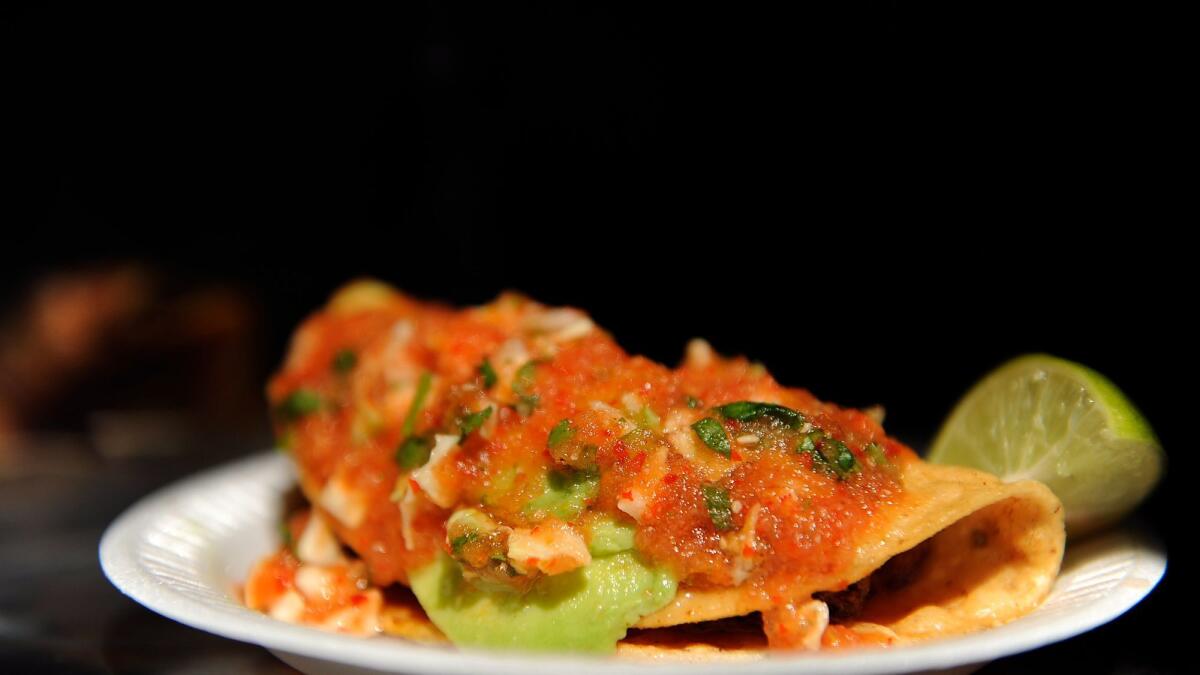
When out-of-town friends come to Los Angeles, the sushi bars I recommend may vary, and the hot Italian restaurant changes every year, but I take them to the Mariscos Jalisco truck every time. Because there may not be an item of food more reliable than Raul Ortega’s taco dorado de camarones, a fried taco stuffed with impeccably fresh shrimp among other things, slightly crisp around the edges, sluiced with a juicy, spicy tomato salsa and garnished with a bit of ripe avocado on the side. The tacos taste of clean oil and chile, toasted corn and the sea — a recipe imported from Ortega’s hometown of San Juan de los Lagos that has become the culinary symbol of Boyle Heights.
Sapp Coffee Shop
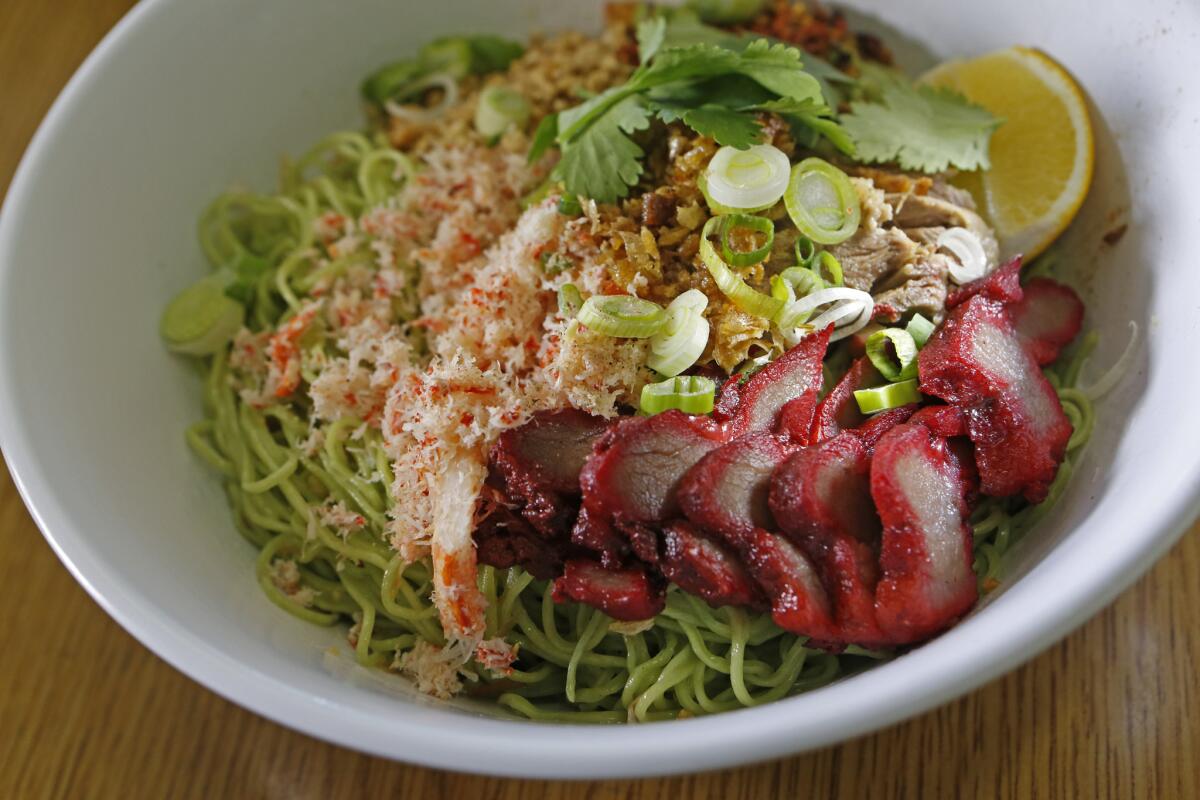
Sapp served a really great dish of chicken with rice the other day. I thought I should mention this because I have probably ordered the same thing 99 out of the 100 last times I’ve been there, a murky, gamy, intensely spicy boat noodle soup loaded with all manner of slithery beef things, a dish that comes perilously close to being my favorite Thai dish in L.A. Other things show up at the table, of course — the gray, unlovely nam sod is actually a terrific, citrus-tart version of the pork and pigskin salad, and the cool jade noodles, dyed green with puréed herbs and tossed with all manner of Chinese barbecue, are ideal on a hot day. The duck noodle soup is secretly the best in Thaitown. You can find pandan and butterfly pea flower infusions sometimes, and exemplary Thai iced coffee.
Mayura
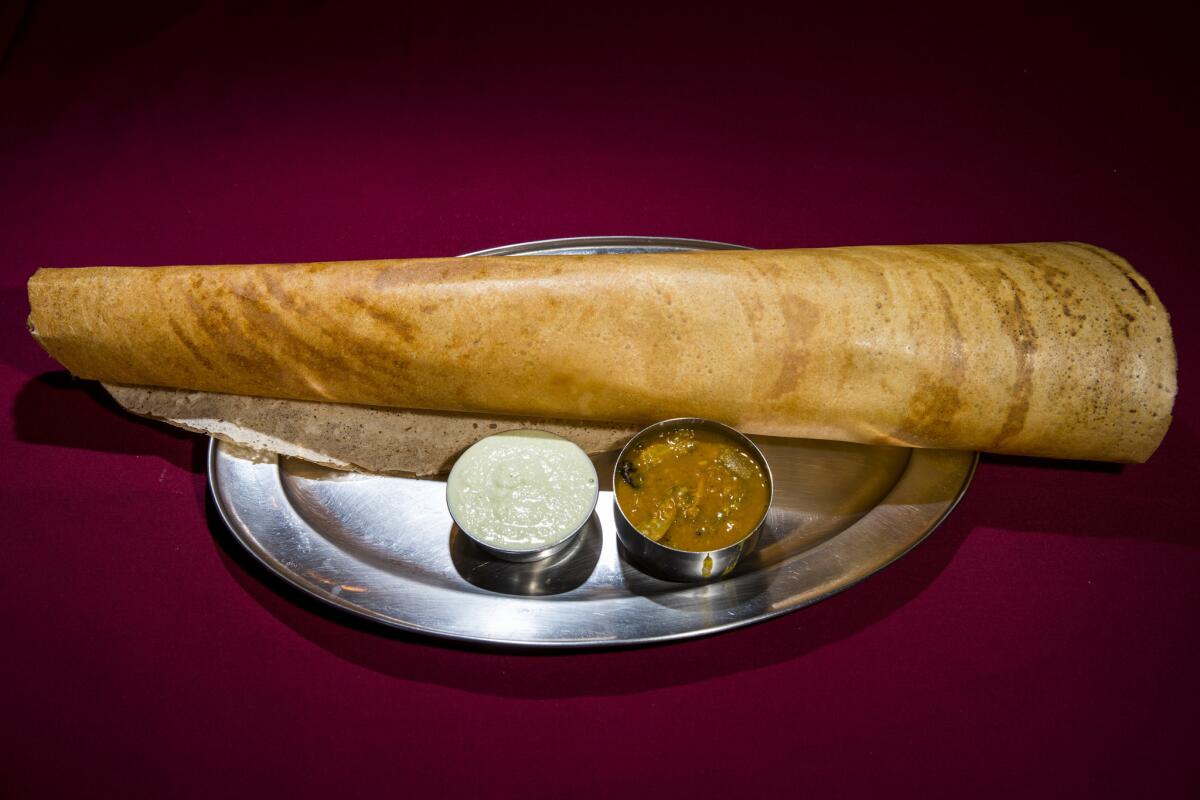
It is hard not to be fond of Mayura, jammed into a mini-mall near Sony, popular with the studio crowd as well as multigenerational families, which specializes in the cooking of Kerala, a Southern Indian state whose flavors have been shaped by a thousand years of spice trading. Even if you frequent other local southern Indian restaurants, it is hard not to admire Mayura’s pure white appam pancakes, its complexly spiced fish curry, or the rice porridge ven pongal, lashed with cumin, cashews and ungodly amounts of melted butter. The avial, a Kerala-style dish of julienne vegetables sautéed with coconut, is luscious but still slightly crunchy, as useful as a condiment as it is satisfying as a main dish. And Mayura may be as all-purpose as it is possible for a restaurant to get, with a vegetarian-friendly menu, a separate halal kitchen preparing mostly north Indian dishes, and a friendly, if lesser, lunchtime buffet.
Howlin’ Ray’s
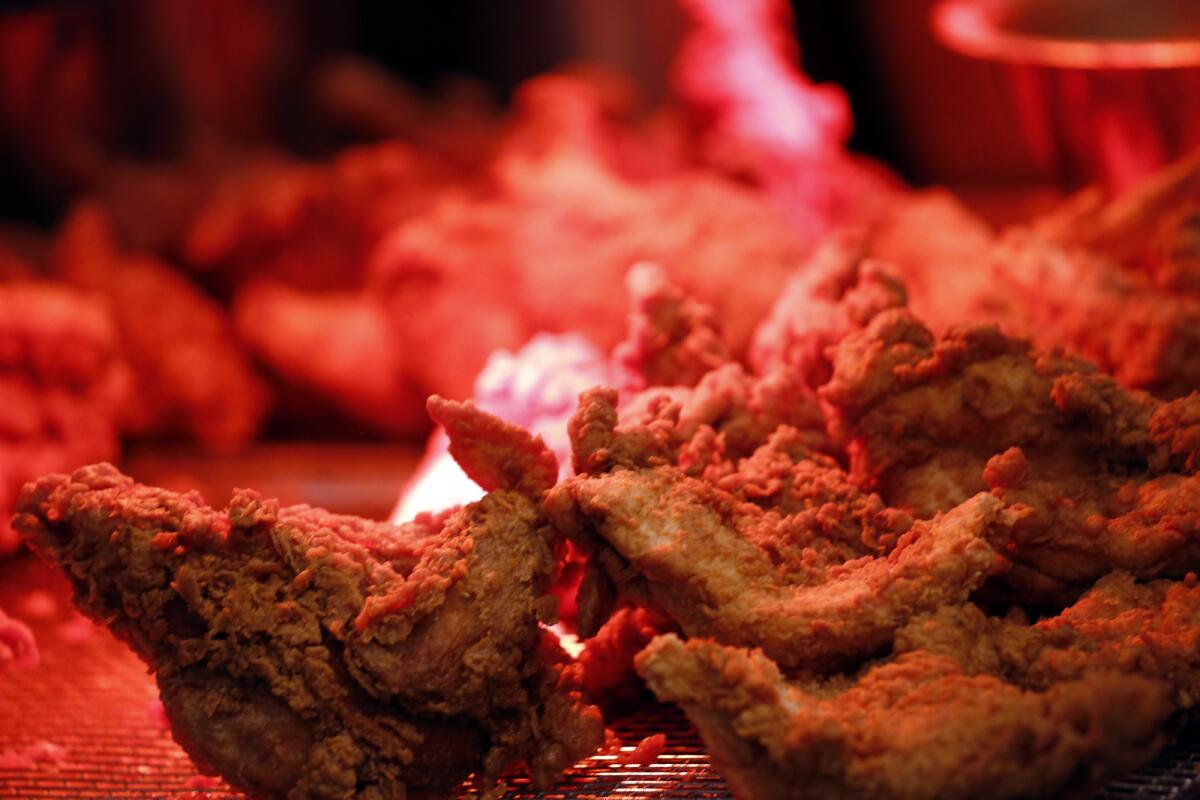
What happens when you take your first bite of Howlin’ Hot fried chicken? You will aim to get as much of the fragrant skin as possible between your teeth, and the experience is of salt, crunch and garlic, overlaid with the pungency of dried peppers. It is excellent fried chicken. Then the punch of heat lands — you may experience it almost as a blow to the chest, but then the endorphins kick in, and you float on an eddy of bliss for a moment. Then you go back in for more. The chicken has won. This scene will have been witnessed by the hundreds perpetually waiting on line in the Chinatown food court, who stare at diners foolhardy enough to order Howlin’ Hot as they might at people staggering off the scariest roller coaster in the amusement park. But Johnny and Amanda Jo Zone thoughtfully provide many other intensities of their Nashville-style hot chicken — medium is plenty spicy — as well as gallons of sweet tea to ease the pain.
Marouch
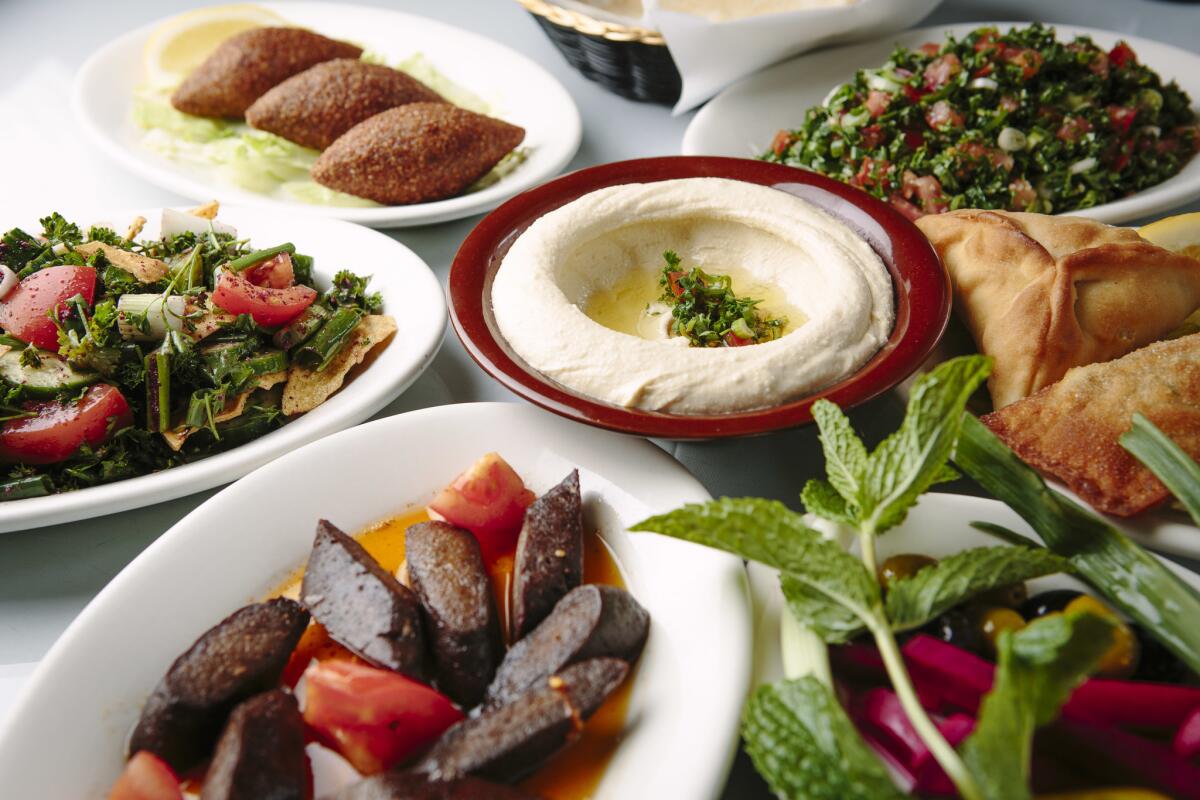
In some parts of town, the rivalry between Marouch and Carousel, the two old-school Armenian-Lebanese restaurants in Little Armenia, is taken as seriously as UCLA-USC. Marouch has the most fragrant roast chicken, but some people lean toward Carousel for kebabs. Marouch has superior hummus and baba ghanouj. The toasted bread salad fattoush is tangier, crisper at Marouch. Maroush has nightly specials of Armenian home cooking in addition to the parade of mezze, barbecued quail and beautiful sujuk sausages, and Sossi Brady’s knafeh, rosewater-scented rice pudding and creamy pudding ashta are as nice as her savory dishes. Advantage: Marouch.
Langer’s
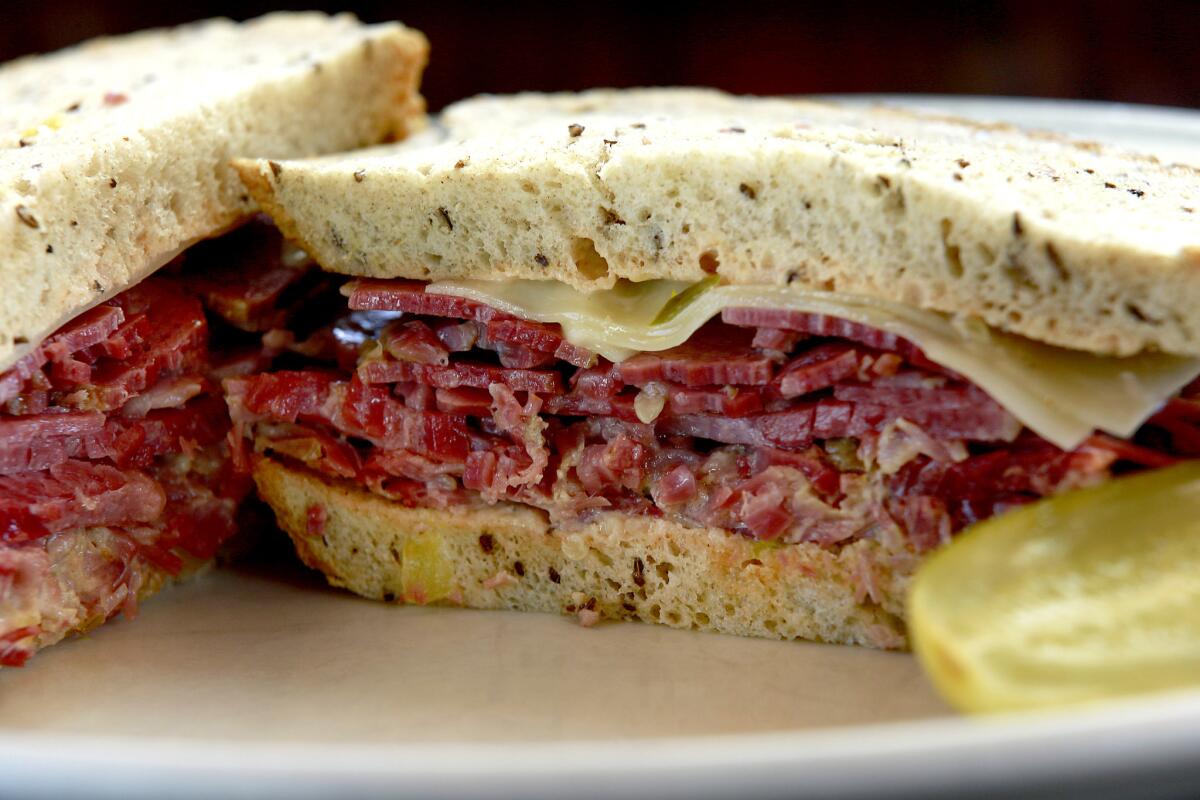
Everyone knows that Langer’s serves the best pastrami sandwich in the world. Guidebooks say so. Nora Ephron and Mimi Sheraton said so. Chefs who flirt with the idea of making pastrami rarely do so without a nod to the noble deli masters of MacArthur Park. The rye bread is double-baked and served hot; the long-steamed pastrami has a firm, chewy consistency and a clean edge of smokiness that can remind you of the kinship between pastrami and Texas barbecue. Still, if you haven’t been to Langer’s in a few years, you might be surprised to see the long lines outside the delicatessen on a Saturday afternoon, supplicants waiting for their shot at the No. 19, a baroque concoction of hand-cut pastrami, Swiss cheese, cole slaw and Russian dressing.
More to Read
Eat your way across L.A.
Get our weekly Tasting Notes newsletter for reviews, news and more.
You may occasionally receive promotional content from the Los Angeles Times.










